- ALL ARTICLES
- How To Study Effectively
- Motivation & Stress
- Smarter Study Habits
- Memorise Faster
- Ace The Exam
- Write Better Essays
- Easiest AP Classes Ranked
- Outsmart Your Exams
- Outsmart Your Studies
- Recommended Reads
- For Your Students: Revision Workshops
- For Your Teaching Staff: Memory Science CPD
- Our Research: The Revision Census
- All Courses & Resources
- For School Students and Their Parents
- For University Students
- For Professionals Taking Exams
- Study Smarter Network
- Testimonials


70+ Connective Words To Power Up Your Essays [COMPREHENSIVE LIST]
by Kerri-Anne Edinburgh | Aug 5, 2021
When you’re writing an essay or assignment, you need to use every trick in the book to maximise your marks. And one of the best tools for radically improving your writing is the power of connective words .
Used correctly, connective words can give your writing new depth and meaning, improve readability (important for your examiner!) and demonstrate the logic of your arguments.
Luckily for you, we’ve got plenty of categories, definitions and connectives examples to help you get started…
Psst – this article uses loads of connectives. See if you can spot them in use: we’ve italicised the best examples!
What are connective words?
Simply put, connectives are words – or phrases – that link parts of your writing together.
You’re probably familiar with the most common connective words: and, as, because, but, if, or, so . In fact, I’ve used a few of them already – did you spot them?
Don’t limit your essay writing to the basics though, because there are hundreds of connectives that can help you to demonstrate different ideas, such as cause and effect , or the chronology of events .
We’re going to explore ten types of connectives below, but first , here’s a quick refresher on the grammar behind connective words:
Definitions: The grammatical bit
Understanding the grammar behind your writing might not be your thing – but bear with me, because remembering these six definitions will help you know which connective to use when, and where to place them!
(If you’re just looking for examples of connectives, feel free to skip straight past this bit!)
Connectives fall into three grammatical categories: conjunctions, prepositions, and adverbs.
- For example: and, but, for, or, yet .
- Today , I finished my history assignment but forgot to workout .
- Such as: at, in, of, on, under .
- I need to finish the conclusion of my essay before I go to dinner.
- For instance: upwards, quickly, fortunately .
- My deadline is tomorrow. Fortunately , I proofread my thesis chapter already .
Using adverb and preposition connective words adds specific meaning – and thus clarity – to your writing. They are particularly useful for successful essay signposting .

Definitions part 2: Connectives in sentences
When using connectives, it’s also important to remember that not all sentences are created equal in importance . And so , when connecting them into longer sentences, different types of connectives create different results:
- For example: I find French tricky but I love learning Spanish.
On the other hand,
- A subordinate clause relies on the main clause to make sense. Therefore, these connectives give information about the relationship between the clauses by specifying an order or place to events, or a cause and effect link.
- Here’s an example: I need to do my homework if I want to get a good grade .
A useful type of subordinating connective for essay writing is the:
- For instance: Firstly , I carried out the experiment, and secondly , I analysed the results.
And that’s your grammar refresh done!
If you’re struggling with essay-writing grammar, a great tool for checking your writing is Grammarly * – we use it at Exam Study Expert because it catches a broad range of mistakes. Their blog is also a great place to learn how to use conjunctions , prepositions , adverbs and more.
How to use connective words
So how do you go about using connectives?
In this section, we’re going to discuss the where, what and how …

Where to add connectives:
As we’ve seen , connective words are often found in the middle of a sentence, joining two clauses. But don’t forget you can also use them at the beginning of a sentence to link two consecutive sentences – OR two ideas within your paragraphs (did you see what I did there?).
Some of your connectives will even be linking entire paragraphs and sections – these are often examples of signposting to guide the reader through your section or argument.
What’s more , many connectives are not just single words but phrases. These connectives are particularly useful for essay writing and academic vocabulary. For example: as well as, for an example of this, for instance, in addition to, on the other hand, such as .
What to use connectives for:
When you’re writing an essay or assignment there are plenty of tasks you need to achieve: presenting evidence, making arguments and more.
Happily, connectives can help you achieve all these tasks by clarifying your meaning. You can use connectives for:
- Reinforcing or emphasising a point
- Exemplifying and showing results
- Comparing and discussing points of view
- Constructing a timeline or sequence of events
- Listing points (and signposting them)
- Explaining your argument
- Drawing together conclusions
It’s a long list! So master using connectives and you’ll drastically improve the readability of your writing across all sections of your essay.
How to add in useful connective words:
You’re probably already using basic connectives in your writing.
But if you want to get serious about the benefits to your grades, make sure you’re systematic about how you add them during your essay construction – and (later) proofreading to check they make sense on a large(r) scale!
From experience, I would suggest that the best method for choosing and adding effective connectives is to:
- Sketch out a rough draft of your paragraph or essay section
- Are they separate arguments for the same thing? Or opposite points of view? Do they follow on logically (cause and effect) or chronologically?
- Mark where you want to add signposting connectives to indicate structure
- Check your examples of connective word types and choose options that convey the meaning you need…
And for that purpose, we’ve compiled four lists of connective words for you – including the TOP 70 connectives for effective essay writing! So read on…
Free: Exam Success Cheat Sheet
My Top 6 Strategies To Study Smarter and Ace Your Exams
Privacy protected because life’s too short for spam. Unsubcribe anytime.
Types of connective words
So let’s get down to the really useful stuff: examples of connectives you can use in different situations in your essays!
There are three main types of connectives that we’re going to explore in turn:
- Comparative , Causal, and Temporal
Comparative connective words
These helpful words and phrases are perfect both for comparing similarities in data and arguments, and for pointing out their differences and oppositions. Use them to compare, discuss and argue.
When comparing points, you’ll often be adding to your argument, so these connectives are used for “ addition ”. The most common connectives for addition are: and, also, furthermore, moreover .
Here are some examples in practice:
- Leonardo Da Vinci was an artist and inventor, and also an influential Renaissance humanist.
- Exam Study Expert’s psychologist William offers expert one-on-one exam coaching . Furthermore , you can sign up for a free introductory session!
- My empirical data demonstrates that … ; similarly , theoretical models projected …
On the other hand , you might need to demonstrate and contrast your argument with the opposing point of view with a connective for “ opposition ”. The most commonly used are: alternatively, except, however, unless .
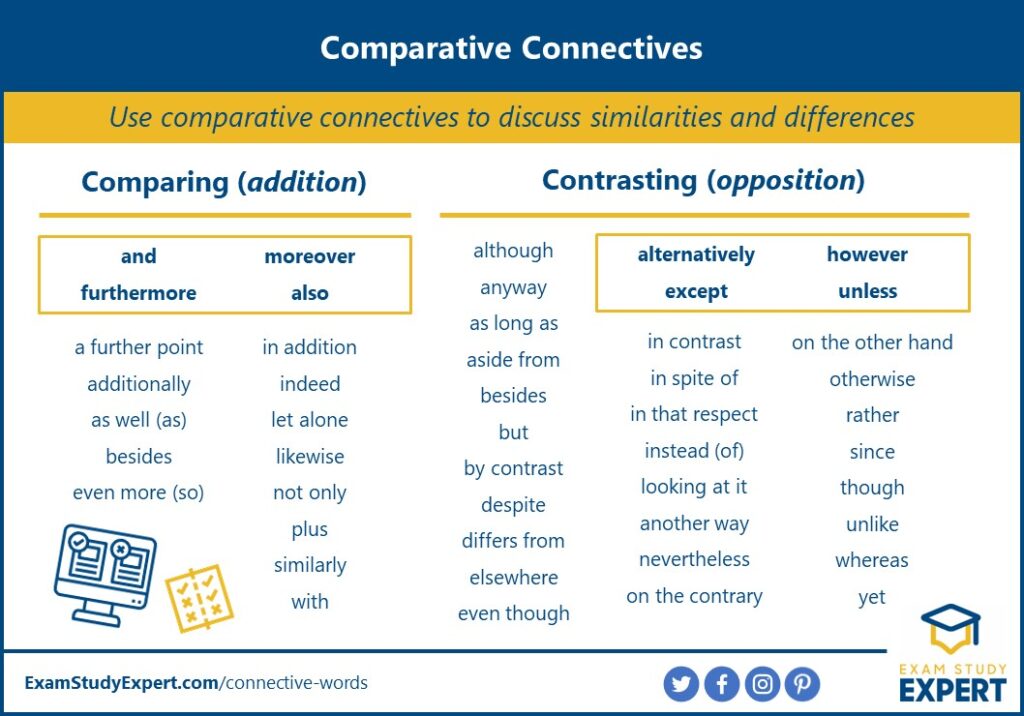
These examples all demonstrate opposition:
- Winston Churchill is best known for his wartime leadership of the United Kingdom, yet he was already in his 60’s when he took office.
- Some students find great study motivation from starting the day with their hardest task. In contrast , others find getting the ball rolling with smaller tasks more effective.
- Our first questionnaire was comprised of six questions. However , for our second questionnaire we …
Causal connective words
Causal connectives are effective for discussing cause and effect – relationships that have logical links that you want to point out and prove.
As such , academic writing is often full of causal connectives, and many of them demonstrate a very academic vocabulary (great for bonus points in your assignment!).
Most essays and assignments have a section (or several sections!) where you need to draw together your facts, ideas and arguments and point out the connections. These are the connectives to turn to at those moments!
The most commonly used are: as such, as a result (of), because, consequently, therefore, thus .
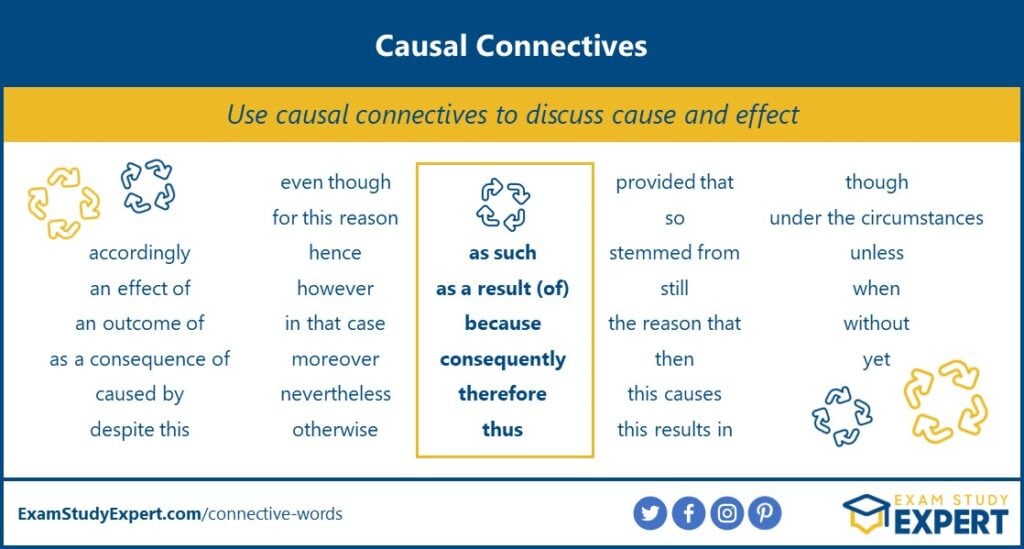
Here are some examples:
- The brains of London taxi drivers have a larger than usual area that deals with memory because they are required to memorise and navigate thousands of streets.
- Flashcards are a highly effective learning and memory tool, provided that you use them correctly.
- This study surveyed over 3,000 students. As a result , we were able to …
Temporal connective words
Whether you’re explaining the sequence of events that led to a historical battle, or demonstrating the steps in your experiment, temporal connectives are a highly valuable tool.
They’re all about discussing time and the chronology of events – what happened before, during and after . Therefore , they make for great signposting words too!
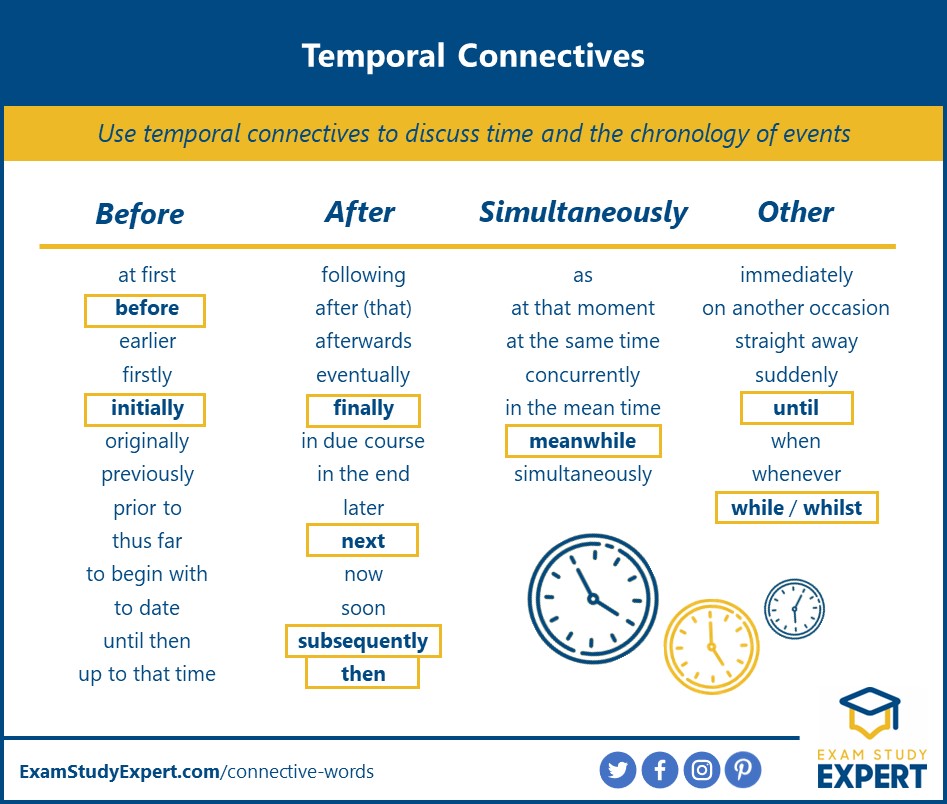
These examples explore each of the four sections in our temporal connectives lists:
- The law of gravity was not widely understood until it was mathematically formulated by Sir Isaac Newton in 1687.
- If you’re stressed about your exams, mindful meditation can be a great help. At the same time ,an inspirational quote might give you the boost you need!
- Initially , the experiment was expected to demonstrate … Eventually , we came to the conclusion that …
The TOP 70 connective words for effective essay writing!
To make sure that you’ve got the tools you need to improve your grades, we’ve compiled this epic list of all the best connectives to use in academic writing.
This is just a selection from the hundreds of connective words and phrases available. So there’s no need to make your essay stale by over-using the same one or two!
If there’s nothing else you grab when you’re ticking off Step #4 from the connectives methodology above – make sure you grab this list!
It covers all the stages of essay structuring and writing, from introduction to conclusion . And includes lists of connectives for:
- Signposting and listing
- Comparing and contrasting
- Illustrating your findings
- Demonstrating cause and effect
- Emphasising points
- Qualifying your arguments
We’ve highlighted the best and most commonly used connectives for each section to ensure you’ve got THE best resource to improve the quality of your essay immediately.

To finish off , here are some examples to get your essay-writing inspiration flowing:
- Firstly , it is well-known that retrieval practice is an effective learning method as compared with re-reading study texts and notes.
- I’m feeling tired tonight. Nevertheless , I must finish my homework and I want to take the dog for a walk.
- When it comes to …, however , there are several effective methods to …, in particular , …
Good luck with your essay!
Now you’ve mastered adding effective connective words to your essay you’re ready for the next step. Be sure to check out our guide on proofreading your assignment before you hand it in. Good luck!
And for more expert, science-backed study resources, sign up to the Exam Study Expert newsletter right here:
The Science Of Studying Smart
Download my free exam success cheat sheet: all my #1 must-know strategies to supercharge your learning today.
Your privacy protected. No spam. Unsubscribe any time.
** Please note : Grammarly is one of very few products we’re sufficiently enthusiastic about to recommend to our Exam Study Expert readers, and we may earn a small commission if you sign up to Grammarly services through the above link.
- Latest Posts
- [2024] Are AP US Government & Politics and AP Comparative Government and Politics Hard or Easy? Difficulty Rated ‘Quite Easy’ (Real Student Reviews + Pass Data) - 5 Jan 2024
- [2024] Is AP Human Geography Hard or Easy? Difficulty Rated ‘Quite Easy’ (Real Student Reviews + Pass Data) - 5 Jan 2024
- [2024] Is AP Microeconomics Hard or Easy? Difficulty Rated ‘Quite Easy’ (Real Student Reviews + Pass Data) - 5 Jan 2024
such an informative blog for the aspirants who are preparing for any exams
Submit a Comment Cancel reply
Your email address will not be published. Required fields are marked *
This site uses Akismet to reduce spam. Learn how your comment data is processed .
Read My Test-Taking Technique Book For More Marks In Exams

Top Picks: Recommended Reading From The Blog
How To Study Effectively : Ultimate Guide [READER FAVOURITE]
Exam Memorization Secrets
Inspirational Exam Quotes
Finding The Perfect Study Routine
Pomodoro Method : 9-Step Guide
Best Books About Studying
Listen To The Podcast

- Grammar Lessons
- Grammar Exercises
- Grammar Quizzes
- Mixed Tests
- PDF Worksheets
- Beginners Lessons
- Easy Worksheets
- Beginners Tests
- Reading Exercises
- Drag & Drop Grammar
- English For Kids
- Kids Word Games
- Picture Vocabulary
- Reading Tests
- Short Dialogues
- Short Sentences
- Closest in Meaning
- Irrelevant Sentence
- ESL Paragraphs
- GRE Reading
- Text Completion
- GRE Equivalence
- SAT Sentence
- Essay Writing
- Vocabulary Exercises
- Study Skills Tips
- Drag & Drop Vocab
Connectives List

75 linking words for academic writing (+examples)
Linking words play an important role in academic writing: They connect different paragraphs, sections or ideas in a text. Therefore, they considerably improve the readability and argumentation of academic texts such as a thesis, dissertation, essay or journal publication. This list of 75 linking words includes examples of how they can be used in academic writing.
Disclosure: This post may contain affiliate links, which means I may earn a small commission if you make a purchase using the links below at no additional cost to you . I only recommend products or services that I truly believe can benefit my audience. As always, my opinions are my own.
Linking words expressing order and sequence in academic writing
Linking words expressing additions in academic writing, linking words expressing cause and effect in academic writing, linking words expressing contrasts and comparisons in academic writing, linking words expressing emphasis in academic writing, linking words expressing illustrations in academic writing, linking words expressing summaries and conclusions in academic writing, linking words expressing conditionality in academic writing, linking words expressing generalisations in academic writing, linking words expressing concessions in academic writing.
1. First(ly), second(ly), third(ly)
Example: First, I review the existing literature on cross-border collaboration. Second, I explain the methodology …
Example: The thesis starts with a literature review. Next, I describe the case study design.
Example: Finally, recommendations for future research are presented.
4. Subsequently
Example: Study participants underwent several experiments and were subsequently examined.
5. Afterwards
Example: The event increased public awareness of this issue. Afterwards, politicians debated it more openly.
6. Eventually
Example: Eventually, this led to the creation of a social movement.
Example: Before scientists discovered the role of neurons in information processing, they assumed that…
8. Previously
Example: Previously, scholars believed that nurture was the most important factor in a child’s development.

Example: Scholars examine the causes and effects of poverty.
10. Furthermore
Example: Furthermore, the data illustrates the number of chemicals that can be found in drinking water.
11. Additionally
Example: Additionally, the interviewee lamented a lack of attention to his work.
12. As well as
Example: Scholars utilise qualitative as well as quantitative methods to study this phenomenon.
13. Besides
Example: Besides the public outreach component, we wrote a handbook to disseminate the research results in the academic community.
Example: The financial compensation was also appreciated by the study participants.
15. Moreover
Example: Moreover, interviewees were asked to describe their own experiences.
You may also like: How to paraphrase a quote: 4 simple strategies
16. Because
Example: This theory was ultimately rejected because it was built on a flawed dataset.
Example: The outcomes improved since different parties joined forces.
Example: As the number of studies increases, better conclusions can be drawn.
Example: Scientists realised that the data analysis had flaws. So they decided not to run the same data analysis again.
20. Therefore
Example: Many researchers have conducted this experiment with similar results. Therefore, this theory can be debunked.
21. Consequently
Example: The literature highlights the importance of age and physical fitness. Consequently, these factors will be investigated further.
Example: Due to a low response rate, the study’s validity is low.
23. Nevertheless
Example: One academic study found the opposite results. Nevertheless, it can be argued that…
Example: Many scholars have explored this issue. Yet, to date, no inclusive framework exists to explain…
25. Although
Example: Although a confidentiality agreement was provided, study participants were hesitant to disclose private information.
26. In spite of
Example: In spite of the different study contexts, all experiments pointed to similar results.
27. Whereas
Example: People often stated that they are aware of the rules whereas they behaved as if they did not.
Example: While older studies often emphasise structural effects, newer ones tend to highlight the role of agency.
29. In contrast
Example: In contrast to previous findings, my analysis shows that…
30. Similarly
Example: One study found that the majority of residents in disadvantaged areas do not have access to sufficient resources. Similarly, my research revealed that most residents live too far away from the services and resources they would need to climb the social ladder.
31. Equally
Example: E qually important, however, is the role of personal beliefs in decision-making processes.
32. Likewise
Example: The interviewee considered this issue important and expected his colleagues to do likewise.
33. On the other hand
Example: On the one hand, research in this field advanced considerably in the last 20 years. On the other hand, a lot remains unclear.
Example: Unlike social scientists, physical scientists often conduct laboratory examinations.

If you are looking to elevate your writing and editing skills, I highly recommend enrolling in the course “ Good with Words: Writing and Editing Specialization “, which is a 4 course series offered by the University of Michigan. This comprehensive program is conveniently available as an online course on Coursera, allowing you to learn at your own pace. Plus, upon successful completion, you’ll have the opportunity to earn a valuable certificate to showcase your newfound expertise!
35. Particularly
Example: Particularly relevant for this study is the molecular orbital theory.
36. Especially
Example: Especially younger interviewees expressed dissatisfaction with the status quo.
37. Above all
Example: Above all, this method can generate better insights into the physical processes at hand.
Example: Indeed, motivation turned out to be a defining factor of academic success.
38. Clearly
Example: Clearly, these scholars were not aware of recent advances in medical sciences.
39. Definitely
Example: This was definitely the most important event of the year.
40. Importantly
Example: More importantly, the findings underscore the importance of conflict resolution.
41. Undoubtedly
Example: Undoubtedly, all stakeholders had good intentions.
42. Obviously
Example: Obviously it is too early to draw final conclusions.
43. Of course
Example: Of course, this study should be replicated in a different context.
44. Surprisingly
Example: Surprisingly, all results were unambiguous.
45. Such as
Example: Scientists have explored different parts of the problem, such as CO2 emissions and hydrological processes.
46. For example
Example: Many interviewees were nervous. For example, when asked to describe the event, some of them started to stutter.
47. For instance
Example: Scholars have criticised this approach for different reasons. For instance, they argued that qualitative methods are insufficient to draw generalisable conclusions.
48. In this case
Example: Difficulties arise when no study participants can be found. In this case, alternative methods should be considered.
50. To conclude
Example: To conclude, the empirical analysis supports previous research findings.
51. In conclusion
Example: In conclusion, the reviewed literature highlights a clear research gap.
52. To sum up
Example: To sum up, a mixed methods approach is a better choice than a purely quantitative one.
53. In summary
Example: In summary, it is my opinion that conditions should be improved.
54. In short
Example: In short, scholars call for more research on climate change mitigation.
55. Altogether
Example: Altogether, these examples support the main argument.
Example: Energy supply became a growing problem. Thus, new policies were implemented.
Example: The first dataset was incomplete. Hence, a new dataset had to be developed.
Example: Unless stated otherwise, I refer to the concept as…
59. As long as
Example: As long as the conditions do not change, the results should remain stable.
Example: If scientists study this phenomenon in the future, they should pay attention to structural drivers.
61. Provided that
Example: Provided that nothing changes, the effects on society will be negative.
Example: Should the distribution change, it is fair to expect…
63. Even if
Example: Even if more experiments are conducted, human behaviour remains hard to predict.
Example: Often, this issue was flagged by interviewees themselves.
65. Commonly
Example: Commonly, this criterion is used for categorising plants.
66. Overall
Example: Overall the data confirmed the hypothesis.
67. Typically
Example: Typically emotions run high in such situations.
68. Generally
Example: Generally speaking, scholars address this issue from two angles.
Example: Mainly researchers in the global North discuss this phenomenon.
Example: Mostly, these results cannot be replicated outside of the lab.
71. Even if
Example: This is hard to prove. Even if the study sample is large enough.
72. Regardless of
Example: Regardless of their genetic makeup, mice showcased the same symptoms.
Example: Albeit experiencing setbacks, successful students do not get discouraged.
74. Admittedly
Example: Admittedly, the validity of this study should be increased.
75. Nonetheless
Example: Nonetheless, this study can be seen as a valuable contribution to the international literature.
Master Academia
Get new content delivered directly to your inbox.
Subscribe and receive Master Academia's quarterly newsletter.
How to paraphrase a quote: 4 simple strategies
The best coursera courses for phd researchers in 2023, related articles.

How to peer review an academic paper

Theoretical vs. conceptual frameworks: Simple definitions and an overview of key differences

How to write a fantastic thesis introduction (+15 examples)

- TEFL Internship
- TEFL Masters
- Find a TEFL Course
- Special Offers
- Course Providers
- Teach English Abroad
- Find a TEFL Job
- About DoTEFL
- Our Mission
- How DoTEFL Works
Forgotten Password

- Linking Words & Connector Words: Ultimate List With Examples
- Learn English
- James Prior
- No Comments
- Updated February 23, 2024

Linking words and connector words are essential tools for effective communication and writing. They play a crucial role in connecting ideas, enhancing coherence, and guiding the flow of information. Whether you’re writing an essay, giving a presentation, or engaging in a conversation, using appropriate linking words can greatly improve the clarity and effectiveness of your message.
In this ultimate list of linking words, we have compiled a comprehensive collection of linking words along with examples to help you understand their usage and apply them in various contexts. From words that highlight contrast and similarity to those that indicate cause and effect or order of importance, this list covers a wide range of linking words to suit different purposes.
Ready to link your words? Let’s get started!
Table of Contents
What are linking words?
Linking words, also known as connector words or transition words, are words or phrases that connect ideas or parts of a text, providing coherence and smoothness to the overall flow of information. They serve as bridges between sentences, paragraphs, or even larger sections of a document, helping to establish relationships, indicate contrasts, add information, show cause and effect, provide examples, and more.
Here are some common categories of linking words with examples:
Linking words for addition
Addition: Words that show the addition of information or ideas.
These linking words and phrases can help you add information, reinforce ideas, or provide further examples in your writing or conversation. Use them appropriately to expand on your points and enhance the overall coherence and richness of your communication.
- She is fluent in English, and additionally, she speaks French and Spanish.
- The report highlights the benefits of renewable energy; furthermore, it emphasizes the importance of conservation.
- The new system not only improves efficiency but moreover, it reduces costs.
- In addition to his regular job, he volunteers at a local charity.
- She not only excels in academics but also actively participates in extracurricular activities.
- The team consists of experienced professionals as well as enthusiastic newcomers.
- The company values teamwork; likewise, it fosters individual growth and development.
- Besides working full-time, he manages to pursue his hobbies and spend time with famil
- The website offers free shipping; what’s more, customers can enjoy a 30-day money-back guarantee.
- On top of their regular duties, employees are encouraged to take part in professional development opportunities.
- Developing strong interpersonal skills is equally important as acquiring technical knowledge.
- The event attracted a large audience, not to mention the media coverage it received.
- Along with the new software update, customers will also receive enhanced customer support.
- The company achieved its sales targets for the year; what is more, it surpassed them by 20%.
- The team completed the project ahead of schedule; besides that, they received positive feedback from the client.
- The company’s commitment to quality, coupled with its competitive pricing, sets it apart from its competitors.
Linking words for contrast
Contrast: Words that highlight differences or contrasting ideas.
These linking words and phrases can help you express contrasting ideas and show the differences between two or more concepts or situations. Remember to use them appropriately based on the context and your intended meaning.
- She studied hard; however, she didn’t pass the exam.
- John loves traveling; on the other hand, his sister prefers staying at home.
- The weather was terrible; nevertheless, they decided to go for a walk.
- He had a sprained ankle; nonetheless, he played in the soccer match.
- Despite the rain, they went to the beach.
- In spite of the traffic, they arrived on time.
- Although it was late, they continued with their work.
- Even though she was tired, she went to the gym.
- I enjoy reading, while my brother prefers watching movies.
- Sarah loves cooking, whereas her husband prefers eating out.
- Unlike his friends, Mark is not a fan of horror movies.
- She hates winter; conversely, I love it.
- She expected him to be upset; on the contrary, he was happy.
- They planned to go to the cinema, but instead, they stayed home and watched a movie.
- The cat is small and playful, in contrast to the dog, which is big and lazy.
- He enjoys sports; conversely, his sister prefers art.
- On one hand, the book is interesting; on the other hand, it’s quite lengthy.
- They could go by car, or alternatively, they could take the train.
- The movie received mixed reviews; nevertheless, it became a box office hit.
- She didn’t pass the test, but in any case, she learned a lot from studying.
Linking words for similarity
Similarity: Words that highlight similarities or shared ideas.
These linking words and phrases can help you express similarities between two or more ideas, situations, or individuals. Use them appropriately based on the context to highlight shared characteristics or experiences.
- Sarah enjoys reading; likewise, her brother is an avid reader.
- John and Emily both love hiking; similarly, they enjoy spending time in nature.
- Just as Sarah likes swimming, in the same way, her best friend enjoys diving.
- Jack has a passion for photography, similarly to his sister who is also an enthusiast.
- Just like her mother, Jane has a talent for playing the piano.
- The two artists approach their work in a similar vein, both using vibrant colors and bold brushstrokes.
- Mark loves cooking, and by the same token, he also enjoys experimenting with new recipes.
- As the workload increased, the stress levels of the employees correspondingly rose.
- Both Sarah and Emily are equally skilled in playing the guitar.
- The designer creates unique clothing pieces, and in a similar fashion, the jewelry maker crafts one-of-a-kind accessories.
- Just as the sun rises in the morning, the moon appears in the evening.
- The teacher explains complex concepts in a simple and understandable way, in the same manner as her colleague.
- He enjoys hiking and camping, and his friends, likewise, too, share his enthusiasm for outdoor activities.
- Just as a bird builds its nest with care and precision, in the same way, an architect plans and constructs a building.
- The two books explore themes of love and loss, along similar lines, inviting readers to contemplate the human experience.
- As with all great artists, Picasso’s work continues to inspire and influence generations.
- Exercise is essential for physical health, and just as importantly, it is crucial for mental well-being.
- Much like a puzzle, life consists of various pieces that fit together to form a bigger picture.
Linking words for cause and effect
Cause and Effect: Words that demonstrate cause and effect relationships.
These linking words and phrases can help you express the cause-and-effect relationship between events or actions. Use them appropriately based on the context to convey the reason and result of a particular situation or occurrence.
- He failed the exam because he didn’t study.
- They arrived early since they left home on time.
- As a result of heavy rainfall, the streets were flooded.
- The event was canceled due to bad weather conditions.
- The store was closed, therefore, they had to find another place to shop.
- He missed the train, consequently, he arrived late to the meeting.
- Owing to a power outage, the concert was postponed.
- She didn’t have enough sleep, thus, she felt tired throughout the day.
- He couldn’t attend the party, for this reason, he sent his apologies.
- The storm caused damage to the houses, resulting in the need for repairs.
- The baby was hungry, so she started crying.
- Lack of exercise and poor diet often leads to weight gain.
- They missed the train because of heavy traffic.
- The roads were icy, this is why there were many accidents.
- They spent all their money, as a consequence, they couldn’t afford the trip.
- He quit smoking, and since then, he feels healthier.
- The company introduced a new product, and in turn, its sales increased.
- She studied hard so that she could pass the exam.
Linking words for time and sequence
Time and sequence: Words that indicate time or sequence of events or actions.
These linking words and phrases can help you express the chronological order and sequence of events or actions. Use them appropriately to guide your audience through the progression of ideas or to outline the steps in a process or narrative.
- Firstly, let’s discuss the main causes of climate change.
- Secondly, we need to consider the potential solutions to the problem.
- Next, we will move on to the implementation phase of the project.
- We need to complete the research phase first. Then, we can start analyzing the data.
- After that, we can proceed with the construction of the building.
- The company experienced financial difficulties. Subsequently, they had to lay off several employees.
- The team was working on the project. Meanwhile, the marketing department was preparing the promotional materials.
- The two processes are happening simultaneously, ensuring efficient production.
- The report will be ready in a week. In the meantime, please proceed with the other tasks.
- During the meeting, we will discuss the budget and timeline.
- While he was studying, his friends were playing video games.
- Please wait here until your name is called.
- We need to complete the paperwork before the deadline.
- She attended the conference, and afterward, she shared her insights with the team.
- Finally, we reached an agreement after a long negotiation process.
- In the end, they decided to cancel the project due to budget constraints.
- The presentation was engaging, and at the same time, informative.
- Initially, he struggled with the new software, but with practice, he became proficient.
- At first, the project seemed overwhelming, but with proper planning, it became manageable.
Linking words for order of importance
Order of Importance: Words that highlight the hierarchy or ranking of ideas based on their significance.
These linking words and phrases can help you establish the order of importance when presenting ideas or arguments. Use them to emphasize the significance of certain points, highlight key considerations, or guide the reader’s attention to the most critical aspects.
- Most importantly, we need to prioritize the safety of our employees.
- Above all, we must prioritize the needs of our customers.
- The company’s success primarily depends on effective leadership and strategic planning.
- First and foremost, we need to address the urgent issue of inflation.
- The new policy chiefly focuses on reducing waste and promoting sustainability.
- Notably, the project resulted in significant cost savings for the organization.
- Above anything else, maintaining a high standard of quality is our top priority.
- It is essential to note that effective communication is the foundation of strong relationships.
- It is worth mentioning that the company’s ethical practices have earned it a positive reputation.
Linking words for exemplification
Example: Words that provide examples or illustrate a point.
These linking words and phrases can help you introduce examples and provide further clarification or evidence to support your statements. Use them to enhance your explanations and illustrate your points effectively.
Here’s a list of linking words and phrases that are commonly used to illustrate an example, along with examples:
- There are many fruits you can choose from, for example, apples, oranges, and bananas.
- Many countries have implemented environmental policies; for instance, Sweden has significantly reduced its carbon emissions.
- I enjoy outdoor activities such as hiking, cycling, and swimming.
- The party was attended by several guests, including friends, family, and colleagues.
- He has many hobbies, like painting, playing the guitar, and photography.
- The company provides various employee benefits, as an illustration, health insurance, retirement plans, and paid time off.
- Let me give you an example to illustrate my point.
- There are several endangered species in the area, namely the African elephant, the Bengal tiger, and the giant panda.
- The city offers various attractions, in particular, museums, parks, and historical landmarks.
- The project requires specific skills, specifically programming and data analysis.
- By way of example, let’s consider the case of a successful startup that disrupted the market.
- To give an example, let’s say you want to improve your fitness; you can try activities like jogging, swimming, or joining a gym.
- The experiment was conducted to demonstrate the effects of temperature on plant growth.
- As a case in point, many countries have implemented renewable energy initiatives to combat pollution.
- I will use a specific scenario to exemplify how the new policy can be implemented effectively.
- The job requires strong communication skills , in essence, the ability to express ideas clearly and persuasively.
- The city has invested in renewable energy projects to reduce its carbon footprint. One example of this is the installation of solar panels on public buildings.
- To be specific, the company offers three main product lines: electronics, appliances, and furniture.
- The data collected serves as proof that the new marketing strategy is effective.
- In a similar manner, many companies have embraced remote work as a response to the pandemic.
Linking words for focusing
These linking words and phrases can help you direct attention or emphasize a specific aspect of your discussion or argument. Use them appropriately to highlight the main points or focus areas, ensuring clarity and precision in your communication.
Here’s a list of linking words and phrases that are commonly used to express focusing or directing attention, along with examples:
- Specifically, we need to address the issue of employee turnover in our department.
- The marketing team has made significant progress, particularly in digital advertising.
- In particular, we need to improve our customer service to enhance customer satisfaction.
- Notably, the company achieved a record-breaking sales figure in the last quarter.
- This task requires attention to detail, especially when dealing with sensitive data.
- Specifically speaking, the new software update addresses the security vulnerabilities.
- Above all, we must prioritize the safety of our employees.
- The company’s success mainly relies on customer satisfaction and brand reputation.
- The primary goal of our project is to reduce waste and promote sustainability.
- Essentially, our focus should be on optimizing operational efficiency.
- Individually, each team member plays a crucial role in achieving our objectives.
- Precisely, we need to adhere to the project timeline to meet the deadline.
- Specifically, with regards to customer feedback, we have received positive reviews.
- The new product line has a sleek design, not to mention its advanced features.
- It is worth noting that the market trends are shifting towards online shopping.
- Above everything else, we need to prioritize the quality of our products.
- In essence, our primary objective is to provide exceptional customer service.
- To be more precise, we should focus on improving our supply chain management.
- In specific terms, the sales team needs to focus on building client relationships.
- More importantly, we need to address the concerns raised by our customers.
Linking words for conclusion
Conclusion: Words that summarize or conclude a text.
These linking words and phrases can help you signal the conclusion of your argument, presentation, or essay. Use them to summarize key points, restate your main argument, or provide a final thought or recommendation.
- In conclusion, it is evident that deforestation poses a significant threat to our planet.
- To sum up, the project was a great success, exceeding all expectations.
- Ultimately, the decision lies in your hands.
- All in all, it was a memorable vacation filled with adventure and relaxation.
- Lastly, I would like to thank everyone for their hard work and dedication.
- In summary, the findings of the study suggest a strong correlation between exercise and mental well-being.
- To conclude, the evidence supports the hypothesis that regular exercise improves cardiovascular health.
- The data collected consistently points to the same conclusion; therefore, we can confidently assert our findings.
- In essence, the research demonstrates that social media has a profound impact on interpersonal relationships.
- The campaign received widespread support, and as a result, donations increased significantly.
- In a nutshell, the project aims to promote sustainability through renewable energy initiatives.
- The experiments consistently yielded similar results; thus, we can draw a definitive conclusion.
- The evidence strongly suggests a link between smoking and lung cancer; hence, it is crucial to raise awareness about the risks.
- In light of these findings, it is necessary to reconsider the current educational policies.
- The company faced financial challenges, and consequently, had to downsize its workforce.
- In conclusion, it can be stated that effective communication is the key to successful teamwork.
- Taking all factors into account, it is clear that globalization has both positive and negative consequences.
- The lack of investment resulted in decreased productivity, as a consequence, the company experienced a decline in profits.
- The study findings reveal a correlation between stress levels and sleep quality; thus, it can be inferred that managing stress positively affects sleep.
- Given these points, it is evident that the project should be prioritized for its long-term benefits.
If you’d like more examples, check out this list of other ways to say in conclusion .
Conclusion: Ready to link your words?
These are just some examples of linking words, and there are numerous other linking words and phrases available for different purposes and contexts. Using them appropriately can greatly enhance the clarity and coherence of your writing or speech. So, if you want to become more fluent in English, it’s time to start thinking about linking words!
- Recent Posts
- How to Become a Digital Nomad: A Step-By-Step Guide - May 10, 2024
- How to Teach English to Young Learners: 9 Helpful Strategies - May 2, 2024
- Is Teaching English Abroad Worth It? A Teacher’s Perspective - May 1, 2024
More from DoTEFL

11 Easiest Languages to Learn for English Speakers
- Updated February 5, 2024

Decoding Business Structures: A Guide for Tutoring Entrepreneurs
- Updated April 29, 2024
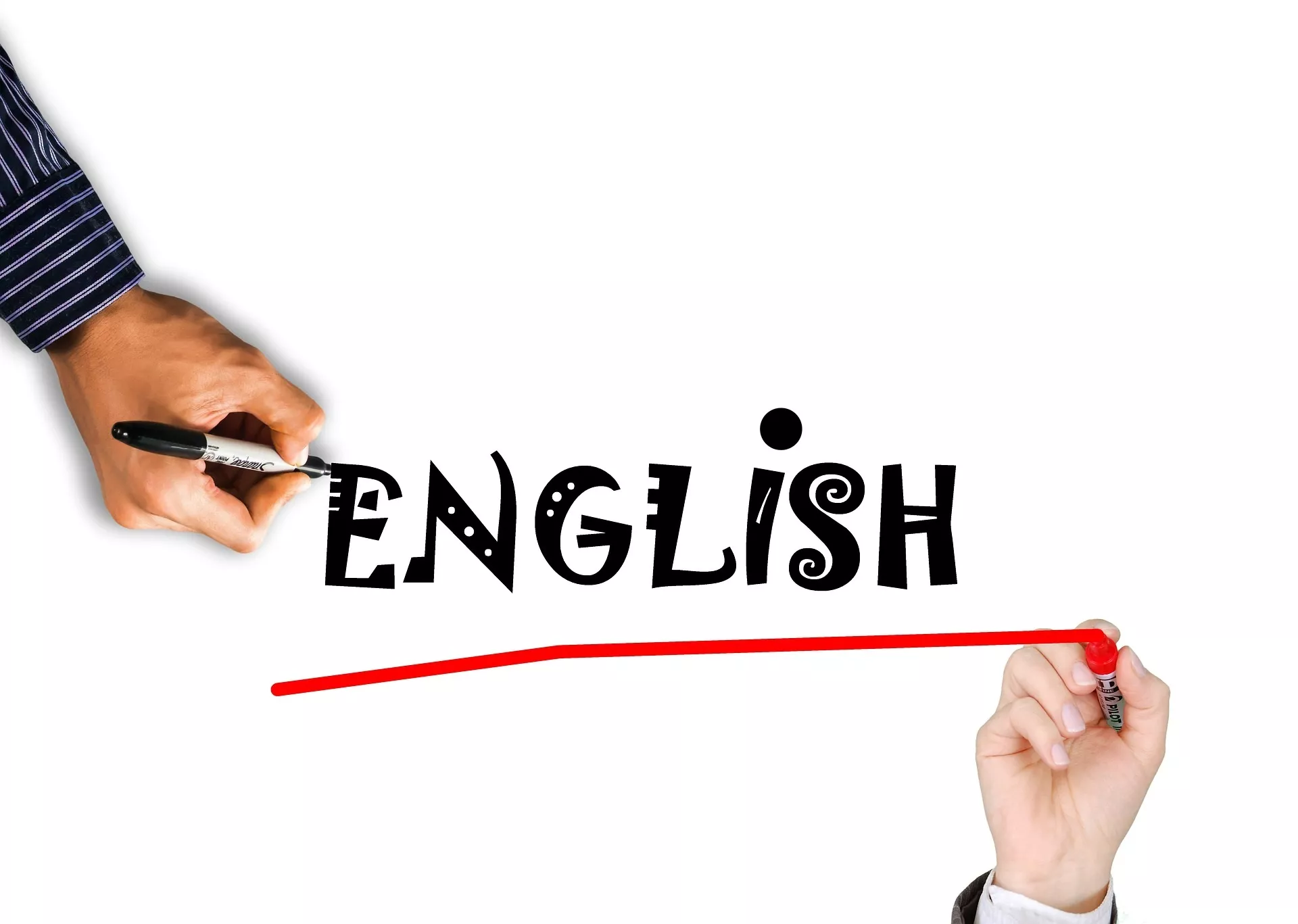
How to Teach English to Spanish Speakers: 19 Must Have Tips
- Updated January 17, 2024
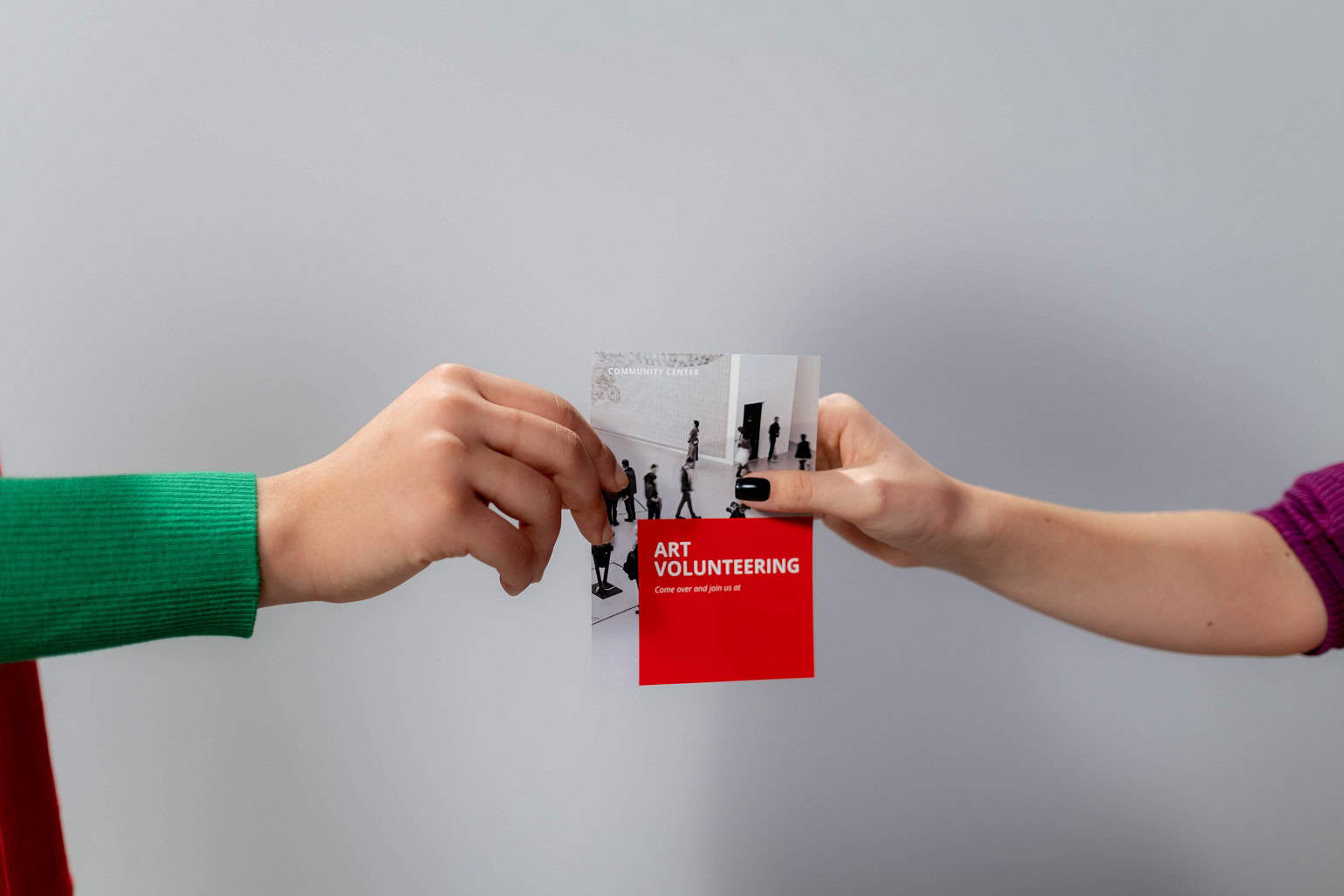
Flyer or Flier? What’s the Difference and Which is Correct?
- Updated May 12, 2023

27 Best AI Tools for Teachers
- Updated April 23, 2024

To Log in To, to Log Into, or to Login To? Which is Correct?
- Updated February 28, 2023
- The global TEFL course directory.
- Academic Skills
- Reading, writing and referencing
- Writing effectively
Connecting ideas
How to connect ideas at the sentence and paragraph level in academic writing.
What is cohesion?
Cohesion refers to the way we use vocabulary and grammatical structures to make connections between the ideas within a text. It provides flow and sequence to your work and helps make your paragraphs clear for the reader.
Cohesive devices are words and expressions that show relationships between parts of text and ideas, such as cause and effect, time, addition, or comparison and contrast.
Watch the video to learn how to make your ideas link together and your narrative flow.
How can I create cohesion?
Let’s look at types of cohesive devices.
Linking words
Academic writing usually deals with complex ideas. To enable the reader to follow your thoughts, they need to be clearly and smoothly linked. To join ideas and sentences, we use a number of connecting words and phrases. For example:
Additionally, and, also, apart from this, as well (as), in addition, moreover, further, furthermore.
If, in that case, provided that, unless.
Correspondingly, equally, for the same reason, in a similar manner, in comparison, in the same way, on the one hand, similarly.
Alternatively, although, but, conversely, despite, even so, even though, however, in contrast, in spite of, instead, on the contrary, contrary to, nevertheless, nonetheless, notwithstanding, on the other hand, rather, still, though, yet, whereas, while.
Again, in fact, interestingly, indeed, it should be noted (that), more important(ly), most importantly, to repeat, (un)fortunately, unquestionably.
A further instance of this is..., an example of this is…, for example, for instance, such as, thus, as follows.
In other words, more simply, namely, simply put, to put it differently / another way, such as, that is.
A / the consequence of, because, due to, for, the effect of …, since, the result of …
Accordingly, as a result/consequence, consequently, for this reason, hence, so, therefore, thus.
Admittedly, although, clearly though, even though, however, indeed, obviously.
As a rule, for the most part, generally, in general, in most cases, normally, on the whole, usually.
First, second, third (etc), next, before, earlier, finally, following, given the above, later, meanwhile, subsequently, then, to conclude, while.
A note about presentation and style
Check a usage guide for exact rules for punctuation. Many introductory phrases have a comma after them. For example, 'therefore,' and 'in addition,'.
Referring backwards
To avoid repeating words and phrases many times, we use cohesive devices to make references to other parts of a text, such as:
- Pronouns: it, he, she, his, her, they, their
- Demonstratives: this, that, these, those
- Articles: a, the
- Adverbs: previously, subsequently
The Australian prime minister has called an early election. The date was selected to coincide with the start of the Olympic Games. This decision was based on the views of his ministerial advisors, who predicted that voter confidence in the government’s policies would be strong at this time . As previously mentioned , decisions on the timing of elections are based on predictions of voter confidence in the existing government.
In the example above:
- The date - refers back to the election date
- This decision - refers to the prime minister calling an early election
- His - refers to the Australian prime minister
- this time - refers to the start of the Olympic Games
- As previously mentioned - refers to all of the earlier information about the selection of election dates
Looking forward
We often use words and phrases to highlight new information for the reader. This helps make a smooth transition from one point to another. Such phrases include: the following, as follows, below, next, subsequently .
The following dates have been proposed for the forthcoming election: September 8, September 15 and 3 October.
The next issue to be discussed is the influence of the media on voter confidence in the government.
Connecting paragraphs
Apart from using the linking words / phrases above, showing the link between paragraphs could involve writing ‘hand-holding’ sentences. These are sentences that link back to the ideas of the previous paragraph. For instance, when outlining the positive and negative issues about a topic you could use the following:
Example (from beginning of previous paragraph):
- One of the main advantages of X is…
When you are ready to move your discussion to the negative issues, you could write one of the following as a paragraph opener:
- Having considered the positive effects of X, negative issues may now need to be taken into account…
- Despite the positive effects outlined above, negative issues also need to be considered...
It is always important to make paragraphs part of a coherent whole text; they must not remain isolated units.
Checking for paragraph links in your own work
When you are editing your next written assignment, ask yourself the following questions as you read through your work (Gillett, Hammond, & Martala, 2009):
- Does the start of my paragraph give my reader enough information about what the paragraph will be about?
- Does my paragraph add to or elaborate on a point made previously and, if so, have I made this explicit with an appropriate linking word / phrase?
- Does my paragraph introduce a completely new point or a different viewpoint to before and, if so, have I explicitly shown this with a suitable connective?
- Have I used similar connectives repeatedly? If yes, try to vary them using the above list.
Strategies to improve cohesion
- Select a piece of writing, preferably from a textbook or journal article, from your area of study.
- Choose a paragraph and underline or highlight all the different forms of cohesion used, such as using linking words, referring backwards, looking forwards or adding synonyms.
- Which forms are the most common?
- Choose a couple that you think are effective and practice using them in your own writing.
- Try to use a variety of ways to show the relationship between your ideas.

Looking for one-on-one advice?
Get tailored advice from an Academic Skills Adviser by booking an Individual appointment, or get quick feedback from one of our Academic Writing Mentors via email through our Writing advice service.
Go to Student appointments

50 linking words to use in academic writing
It’s very common for students to use long words they don’t understand very well in their essays and theses because they have a certain idea of what academic writing should be. Many students believe that academic writing is wordy and convoluted, and uses a lot of jargon. This leads many students to fall into a trap of imagining that the longer the word, the more impressive and intelligent their writing will seem.
We often see long sentences and multisyllabic words where shorter sentences and simpler words would do. Some students even use Microsoft Word’s thesaurus function to replace a common word with a more complicated word. This is a risky move, because unless you’re very careful, the new word may not carry quite the same meaning as the original, even if it’s similar.
The result can range from funny to confusing, which defeats the purpose of academic writing: to be as clear and concise as possible, using just the right words to convey your argument. Using uncommon words, instead of making your paper seem smarter, generally detracts from your ideas.
To avoid this, using linking or transition words that signpost your arguments can help to clarify your views and show the reader what to expect from certain paragraphs or sentences. These words give structure to the whole, helping you to organise your ideas and assist the reader in understanding them.
We have prepared some flashcards containing linking words you can use in academic writing.
CLICK HERE to download these FREE flashcards
Below is a handy list of words that are both useful and appropriate to academic language.
Describing similarities
Correspondingly
Not only… but also
In the same way
Showing cause and effect
Consequently
As a result
Hence (never ‘hence why’)
Since (try to avoid ‘as’ when showing cause and effect)
Accordingly
This suggests that
It follows that
For this reason
Comparing and contrasting
Alternatively
On the other hand
On the contrary
Showing limitation or contradiction
Despite/in spite of
While (not whilst!)
Nevertheless
Nonetheless

Emphasis, addition or examples
To illustrate
Further (not ‘furthermore’)
First, second and third (not firstly, secondly and thirdly)
For instance
In addition
To summarise
It can be concluded that
As can be seen
Given the above
As described
The best way to get better at writing academic language is to read academic writing. You’ll pick up all sorts of useful tips from published papers in your area of study.

Updated 31 January 2023 Ellen McRae, PhD, AE (IPEd), MNZSTI Senior Managing Editor
Request a quote
Please enter your details and we will email a quote to you.
- Enter the Word Count of your document *
- Name This field is for validation purposes and should be left unchanged.
HELP: FORMATTING
- Choose 'leave formatting as it is' if you would like us to maintain the current formatting in your document. We will make sure it is neat and consistent.
- Choose 'I will upload the formatting guidelines' if you have specific instructions about formatting that need to be followed, for example, if you are submitting a thesis for editing and your university has specific thesis-formatting guidelines. Then, upload these guidelines when you upload your document for editing.
- Choose 'Elite Editing House Style' if you would like us to format your document according to our own guidelines, which have been specially designed to meet general university requirements.
- Choose 'APA 6th edition' if you want your document to be formatted according to the Publication Manual of the American Psychological Association (APA) 6th edition. APA formatting is designed specifically for draft manuscripts of journal articles and certain aspects are not appropriate for a thesis that is divided into chapters and is in its final form. If you are submitting a thesis we will modify APA style according to the preferred thesis style of most universities.
Editing guidelines
Please paste a link to the journal editing guidelines if possible.
Copyright 2024, Elite Editing
Terms & Conditions | Privacy Policy
- Academic writing
- Commonly confused words
- Critical thinking
- PEEL Paragraphs
- Linking/transition words
- Paraphrasing
- Proofreading
- Terms and definitions
- Action Words: What is description, application, analysis and evaluation
Linking/transition words: Things you need to know...
All assignments are written in formal language. You need to ensure that you demonstrate your knowledge and understanding alongside your ability to answer the question/solve the problem.
Below are some ideas to help you to develop your structure and flow.
- Linking / transition words and phrases join ideas, sentences and paragraphs together. They should be used within sentences and to move from one idea to another (between sentences).
These words and phrases indicate the direction, order and flow of ideas. Significantly, they strengthen the quality and structure of your work.
- Redundant Words - less is more. P articularly when trying to reduce the word count, it is important to look for phrases which can be replaced with a single word.
Linking/Transition Words
Transitions link one main idea to another separated by a semi-colon or full-stop. When the transition word is at the beginning of the sentence, it should be followed by a comma:
Among other functions, they can signal cause and effect or sequencing (see examples in the table below).
Linking words: conjunctions
Linking words within a sentence are referred to as coordinating conjunctions. Do not worry about the term: think about the function.
Conciseness / redundant words
Microsoft Word now has an additional feature within the Edito r - it is called conciseness or wordiness.
- If you cannot see the Editor menu a quick tip is to hold down the function (fn key at the bottom left of the keyboard) + F7 (top line of keys).
- From the Refinements section - select Conciseness - if there are any suggestions a number will appear in the box alongside this option
- A dotted line will appear under any groups of groups
- Either select the identified text by clicking with your right mouse button OR click on the down down next to the Conciseness menu.
- MS Word will display any alternative words which you can either select and they will be replaced in your text or reject if you want to keep the original phrases.
Examples: try to replace phrases with a single words which mean the same.
Need to know more...
- Related pages
- External links
- Academic writing Illustrates the main features of academic writing so that you are aware of what it is and what it involves
- Critical Thinking Academic work involves thinking, not just accepting what you read or are told.
- Terms and Definitions Important words appear in your assignments and examinations. The aim of this factsheet is to help you to fully understand what they mean.
Additional resources to help you to improve your confidence and grades:-
- Writing Effectively demonstrates the importance of: clarity, structure, relevance, argument and precision.
- Writing Mechanics gives further examples and resources on areas including: sentence structure, vocabulary, spelling, punctuation and grammar.
Linking/Transition words - Scribbr https://www.scribbr.co.uk/syntax/transition-words-examples/ [Accessed 10 February 2023]
There are many books concerning academic writing, look around Dewey number 808
- << Previous: PEEL Paragraphs
- Next: Paraphrasing >>
- Last Updated: Mar 13, 2024 6:24 PM
- URL: https://libguides.staffs.ac.uk/academic_writing
- Library and Learning Services, Staffordshire University, College Road, Stoke-on-Trent, ST4 2DE
- Accessibility
- Library Regulations
- Appointments
- Library Search

- Memberships
- Institutional Members
- Teacher Members

Formal Linking Words / Cohesive Devices
Linking words can also be referred to as connectors, conjunctions, and cohesive devices. This webpage includes a useful lesson on helping improve students’ knowledge of these linking words. It includes a lesson plan using a kinaesthetic matching activity and worksheet.
Terms & Conditions of Use
Lesson: matching activity.
Cut these up and students match
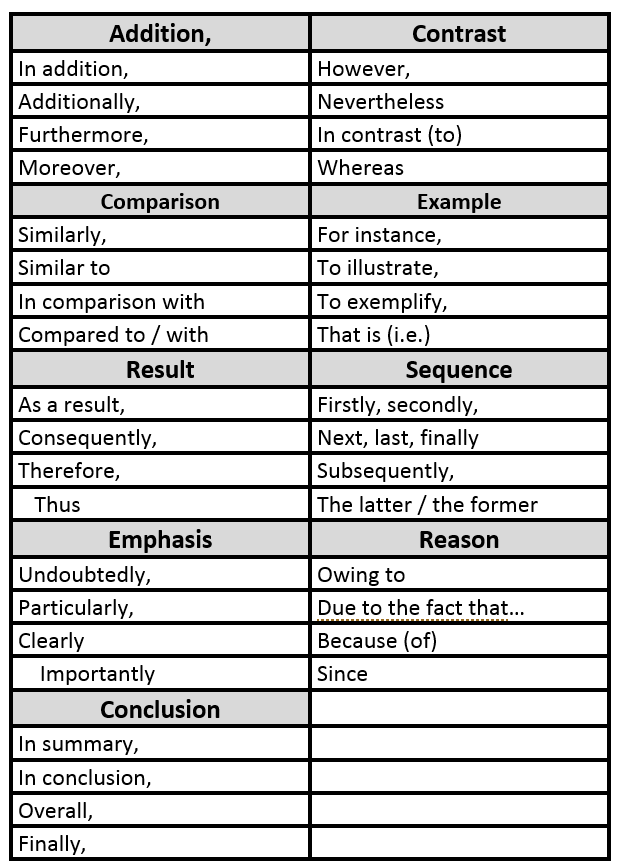
Linking Words Reference Sheet
Print off and give this to students as a helpful reference guide.
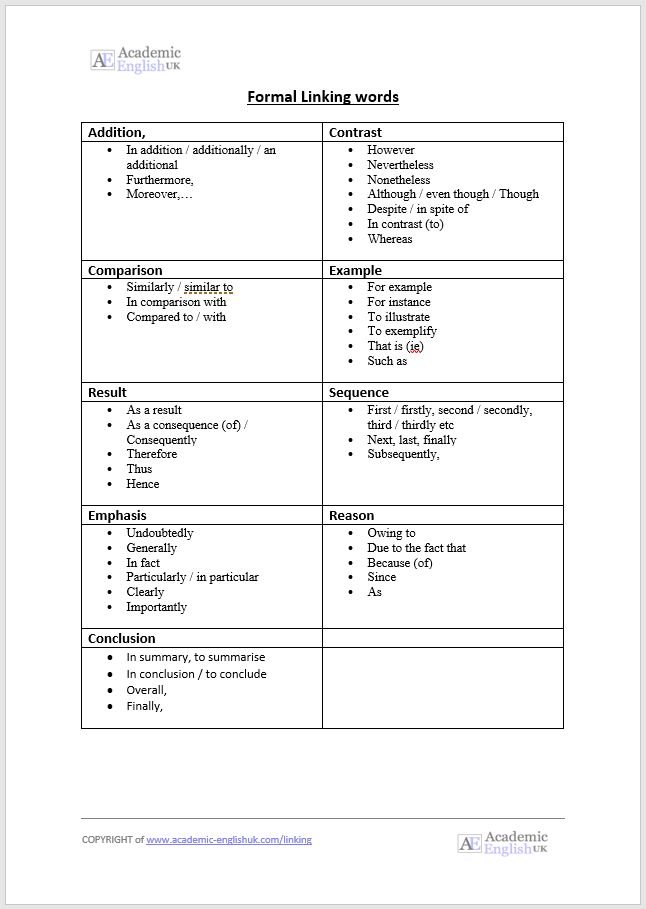
online resources

Medical English

New for 2024

DropBox Files
Members only

Instant Lessons

OneDrive Files

Topic-lessons

Feedback Forms

6-Week Course

SPSE Essays

Free Resources


Charts and graphs

AEUK The Blog

12-Week Course
Advertisement:.

You are using an outdated browser. Please upgrade your browser or activate Google Chrome Frame to improve your experience.
Connectors in English: How to Use Them
Are your essays in English marked poorly despite your grammatically correct sentences?
Have you ever been told that your paragraphs don’t connect to each other even though they talk about the same topic?
This is where English connectors come in—a.k.a., the words I’ve marked in bold above!
Today, I’m going to talk about what connectors in English are, the most common ones you’ll come across and how to practice them.
Once you’re done with this article, I hope you’ll agree that these words and phrases are simply magical!
What Are English Connectors?
English connectors for cause and effect, english connectors for illustration, english connectors for emphasis, english connectors for comparison, english connectors for contrast, english connectors for sequence, english connectors for conclusion, tips for practicing english connectors, and one more thing....
Download: This blog post is available as a convenient and portable PDF that you can take anywhere. Click here to get a copy. (Download)
English connectors are little words and phrases that help you connect sentences, paragraphs and ideas. Used both in spoken and written English, they help make your English sound more logical and structured.
You can think of connectors as like the thread that holds a necklace’s beads (i.e. sentences, paragraphs and ideas) together.
In fact, you probably already use them without even realizing it!
Note that English connectors are different from English conjunctions . While conjunctions link two or more words or clauses within a sentence, connectors establish that two separate sentences or ideas are related to each other.
To help you understand further, I’m going to walk you through some of the most common connectors in English and how they’re used. Some are used formally, while others are more casual. Some are even interchangeable —that is, you can use them in place of similar words.
In everyday conversations , we often need to explain things.
Perhaps you were late for school because your car ran out of gas. Or you want to buy chocolates because you want to surprise your mother on her birthday.
Explaining things will be much easier if you throw in these important English connectors.
Let’s take a look at them!
Giving illustrations or examples helps us prove our point and convince other people to believe us. These words help people understand what you’re trying to say and can help them see why you believe what you believe.
While discussing an issue or idea, you may want to focus on a particular point or example. To make the listener understand the importance of that specific idea, you can use the following connectors.
Sometimes, we need to draw attention to certain similarities to make a point or explain something. This is especially important in writing!
To make better comparisons, use the following English connectors.
Sometimes, we need to express different or contradicting ideas side-by-side. Doing this helps the listener or reader focus on important differences and makes them aware of the many sides of a topic.
These connectors are useful when you’re giving step-by-step instructions or listing points.
Finally , how do you let your reader know that you’ve reached the end? (See what I did there?)
There are certain connectors that we usually use during conclusions or when we’ve reached the end of what we wanted to say. When writing or stating conclusions, you usually repeat the most important points.
Here are some quick tips that’ll help you learn English connectors more efficiently.
Make Your Own Sentences
To explain the meanings and uses of different connectors, I’ve provided example sentences for each. However, you’ll remember them much better if you come up with your own examples.
You can start by using connectors in your diary entries, notebooks, essays and the like. Soon, you’ll find yourself using these connectors in everyday speech as well!
Write a Short Story or Essay
To see the huge difference English connectors can make, try writing a paragraph without any connectors and then rewrite it using some of the connectors above. You’ll quickly realize that your sentences will flow better, sound more logical and become easier to understand.
Learn English with Authentic Content
You probably want to speak English like a native (or at least try to). So why not learn from natives? Try watching a speech in English to get a good idea of how these fit together. Look for the ones with transcripts that you can write notes in, maybe even circling all of the connecting terms as you see them.
FluentU takes authentic videos—like music videos, movie trailers, news and inspiring talks—and turns them into personalized language learning lessons.
You can try FluentU for free for 2 weeks. Check out the website or download the iOS app or Android app.
P.S. Click here to take advantage of our current sale! (Expires at the end of this month.)

Try FluentU for FREE!
Do Online Exercises
Finally, to check whether you’ve understood how to use connectors correctly, you can try online exercises from websites that cover English grammar .
For example, the ones on English Daily and English Grammar are pretty short and can be completed in a few minutes.
There’s also ToLearnEnglish , which provides a brief list of common connectors before you solve the exercise, making it a great resource for review.
Now that you know the most commonly-used English connectors, you can use them in sentences and paragraphs with great confidence. Try your hand at some of the exercises I’ve suggested for practice.
So what are you waiting for?
Get out there and start incorporating these useful English connectors into your everyday life!
If you like learning English through movies and online media, you should also check out FluentU. FluentU lets you learn English from popular talk shows, catchy music videos and funny commercials , as you can see here:

If you want to watch it, the FluentU app has probably got it.
The FluentU app and website makes it really easy to watch English videos. There are captions that are interactive. That means you can tap on any word to see an image, definition, and useful examples.

FluentU lets you learn engaging content with world famous celebrities.
For example, when you tap on the word "searching," you see this:

FluentU lets you tap to look up any word.
Learn all the vocabulary in any video with quizzes. Swipe left or right to see more examples for the word you’re learning.

FluentU helps you learn fast with useful questions and multiple examples. Learn more.
The best part? FluentU remembers the vocabulary that you’re learning. It gives you extra practice with difficult words—and reminds you when it’s time to review what you’ve learned. You have a truly personalized experience.
Start using the FluentU website on your computer or tablet or, better yet, download the FluentU app from the iTunes or Google Play store. Click here to take advantage of our current sale! (Expires at the end of this month.)
Enter your e-mail address to get your free PDF!
We hate SPAM and promise to keep your email address safe

AllAssignmentHelp.com
Linking Words To Use In An Essay
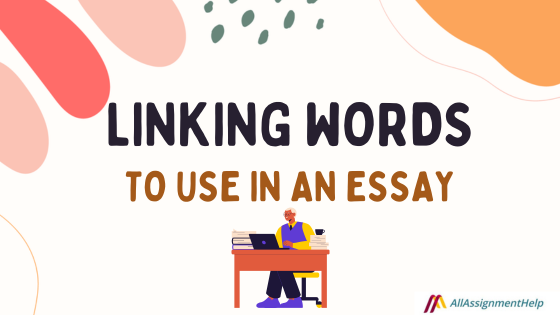
Table of Contents
Concerned that your essay isn’t logical or has enough structure? You can include linking words, or transition words to make it stronger.
An essay is a crucial type of academic paper. It needs to have a clear flow so that the readability is perfect. Precisely stated, the sentences you create should naturally flow into one another. However, using linking words helps ensure that the sentences in your essay make sense. The words serve as the perfect linkers and overpasses to break up sentence segmentation. Additionally, these words can be used to present a conclusion, provide details, summarise, highlight a point, arrange material, compare and contrast ideas, and give illustrations. You might not be aware of these words and how to use them in your essay writing. Don’t worry. We are here to help you! This blog of All Assignment Help will let you know all about linking words and how you can use them in your essay writing to make it more effective and readable.
What are Linking Words?
Linking words are those words that showcase a connection between sentences. They help in forming the uniformity in the essay. Often referred to as transition words, these words serve to establish a connection between paragraphs or other essay sections. Linking words serves as a means of connecting the ideas or thoughts expressed in essays.
Moreover, the use of linking words makes your writing look more logical. Thus, you should use proper linking words to reduce the reading efforts of the readers. Your essay shouldn’t cause readers mental strain to understand it. Therefore, it is essential to make things simple for them.
Essays commonly use linking words in the following places:
- The beginning of a paragraph
- Beginning of a statement that expands on an argument or presents something new
- At the start of a concluding statement
However, you need to use the right to link it from one another sentences or paragraphs. For example, when you are writing an argumentative essay , you need to make sure the flow of linking words is correct and logical so that the argument you are presenting sounds accurate.
Read Here: Words You May Find Confusing
The Reasons Behind Using Linking Words in Essays
Essay sentences that link is a crucial component of academic writing. To put it another way, you cannot write a paper without using them. Otherwise, readers will not understand what you have written. Linking words in the essay are used to:
- Link concepts in your writing
- Organize your ideas and arguments so that readers can follow along and grasp what you are trying to communicate.
- Lead readers from one concept to the next while highlighting their connections.
- Draw readers in and encourage them to continue reading the following sentence or paragraph
- Provide more details
- Strengthen or disprove an argument
- Show the outcome, draw a conclusion, and illustrate how this or that point is affected
Every phrase and paragraph in an essay must lead the reader to the next one using essay maker and connecting words. The purpose of these transitional words is to help readers move from one idea or point to the next.
Three Main Types of Linking Words
There are three main types of linking words i.e. coordinating conjunctions, subordinating conjunctions, and correlative conjunctions. Let’s discuss these three more briefly.
Coordinating Conjunctions
Coordinating conjunctions are utilized to join two or more equally important items. Another name for them is FANBOYS, which is a shorthand for For, And, Nor, But, Or, Yet, and So.
For example, she is putting a lot of effort into her studies to gain admission to a reputable university.
Subordinating Conjunctions
A subordinate clause is joined to a main clause by a subordinating conjunction. However, the supporting clause cannot stand alone as a sentence and is of lesser significance than the main clause.
For example, she stayed home from work because she felt sick.
Correlative Conjunctions
Correlative conjunctions are utilized in pairs to connect two things of equal value. They are used to illustrate the connection between two concepts.
For example, not only did she finish her work, but she also helped her colleagues.
You can learn about the types of linking words by taking an online course. You can also hire someone to take your online class for you to get professional assistance which will help you in acing your online course with great credits.
Useful Linking Words for Essay Writing
It is not an easy task to compose a compelling essay. If you want to make your essay more appealing and expressive, focus on research, presentation, and persuasion. However, if you don’t have a knack for writing, then you will fail miserably in forming a logical essay with judicial use of linking words.
There are various categories of linking words one can use while writing an essay. Here, you will share the main categories and word lists to be used while framing an essay.
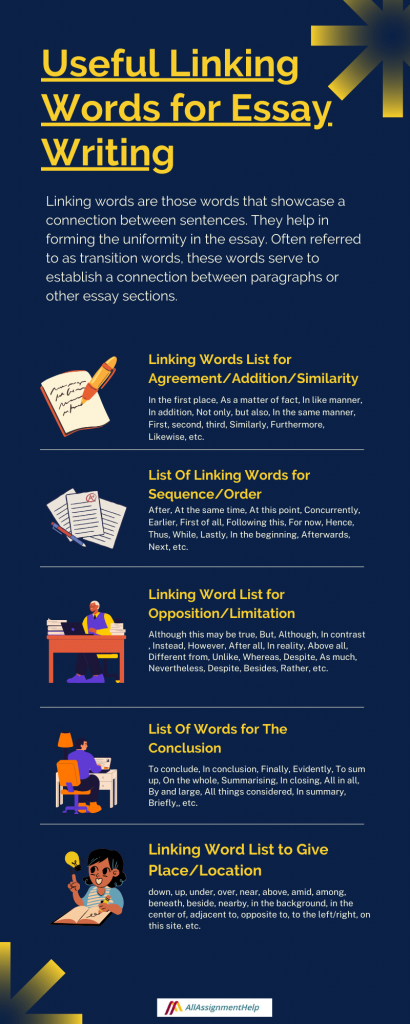
Linking Words List for Agreement/Addition/Similarity
Using linking words can help the reader understand further remarks or concepts in a statement. They might also convey agreement or similarities. These words are also known as additive transition words, which are often utilized in narrative and explanatory essay writings. The words used to link in such context are:
- In the first place
- As a matter of fact
- In like manner
- In addition
- Not only, but also
- In the same manner
- First, second, third
- Not to mention
- In the light of
- Furthermore
- Comparatively
- At the same time
- Together with
- Identically
List Of Linking Words for Sequence/Order
Any kind of essay needs to have flow. Your essay will lose its brilliance if there is a lack of consistency or logical flow of ideas. Here is a linking word list that helps by showing a sequence order in the essay.
- First/ Second/ Third or Firstly/ secondly/ Thirdly
- Primary/ Secondary
- At this point of time
- Concurrently
- First of all
- Following this
- The next step
- In the beginning
- It all started when
- Once upon a time
- To begin with/ To start with
Linking Word List for Opposition/Limitation/Contradiction
However, certain linking words provide additional information, these transitional words and phrases convey opposing concepts in writing. These are:
- Although this may be true
- In contrast
- Different from
- On the other hand
- On the contrary
- Nonetheless
- Even so/though
- Nevertheless
List Of Words for The Conclusion
An essay with a strong conclusion is considered to be excellent. Unfortunately, most students conclude their essays with nearly the same words, but you have the opportunity to do so here. Look at the linking words list for an excellent conclusion:
- To conclude
- In conclusion
- On the whole
- Summarising
- By and large
- All things considered
- In the long run
- For the most part
- By the large
- Consequently
- As a result
Linking Word List to Give Place/Location/Geographical Area
They can be used alone or in combination with words from other categories. They are almost often used together with other terms from the aforementioned groups. They are used to define, limit, or restrict space like the time ones. However, students often face difficulties when using linking words to write about a place and location, which ultimately leads them to buy online essay writing help from professionals. Here is your list of words that you can use to give a location or place.
- in the background
- in the center of
- adjacent to
- opposite to
- to the left/right
- on this site
List of Linking Words for Examples/Support/Emphasis
Transition words that provide examples or strengthen an idea might be used in your essay writing. Here is a list of words that can be used to improvise such contexts:
- In other words
- To put it differently
- For one thing
- In particular
- As an illustration
- In this case
- For example
- For instance
- For this reason
- To put it another way
- To demonstrate
- That is to say
- With attention to
- By all means
- To emphasize
Words for Reason/Reference
You can use these linking words to explain connections between concepts and give explanations for what has started or happened.
- for the purpose of
- seeing that
- with this in mind
- as applied to
- the fact that
- granted that
- in order to
- with this purpose
- considering
- in connection to
- with regards to
- provided that
Linking Words for Time/Chronology/Sequence
Another function of linking words in literature is to illustrate chronology or sequence. These expressions give time a meaning that is included in the time category. These are the types of words that appear in the introduction of an essay when a writer outlines the structure of the work.
- Sooner or later
- Up to the present time
- To begin with
- Straightaway
- In the meantime
- In a moment
- Without delay
Linking Words for Outcomes/Impacts/Repercussions
These particular words are used to demonstrate how one item affected another, to illustrate the outcomes of an action, or to demonstrate how something affected something else. A short list of transitions that work well for this specific category is shown below.
- consequently
- for this reason
- in that case
- as a result
Also Read: Your Guide Towards Writing An Outstanding Short Essay!
Final Thoughts!
The importance of linking words in essay writing cannot be overstated. These words are crucial for connecting concepts and making your essay read as a cohesive whole. Your essay will flow more naturally the more well-organized your thoughts are. Additionally, your writing will have a logical framework and an engaging read when you make use of linking words correctly.
However, to learn more about these words, you can choose to sign up for an online English class. An online English class will help you boost your knowledge about linking words and how you can use them in your writing. Furthermore, whenever you find yourself struggling with your English class and want to pay someone to take my online English class for me, you can hire an online class helper who will be there to take your worries aside.
- Learn English
- Infographics

- English Grammar
Linking Words: List of Sentence Connectors in English with Examples!

Struggling to connect ideas? ‘Connectors in English’ have your back. Connect, express, and impress – all with Connectors in English!
Connectors Definition
Linker Words or Word Connectors are used to link large groups of words: phrases and sentences . You can also use them to connect paragraphs to give them coherence. Sentence connectors are usually placed at the beginning of a sentence and may be categorized as follows:
- This restaurant has the best kitchen in town. However, their staff are quite rude.
2. IN CONTRAST
- House prices have gone up this year. In contrast, car prices seem to be stagnating.
3. NEVERTHELESS
- I was in so much pain I didn’t want to get up in the morning. Nevertheless, I went to football practice as usual.
4. NONETHELESS
- I don’t think Sean has serious behavioural problems. Nonetheless, I’ll talk to him first thing in the morning.
- I’ve asked you a thousand times not to leave your dirty socks on the floor. Yet, you keep doing it.
6. ON THE OTHER HAND
- England has the best language schools. On the other hand, it has the worst weather.
7. BY COMPARISON
- Going out with Jim has its risks. By comparison, being with Tim is as easy as falling off a log.
8. ON THE CONTRARY
- I don’t hate Jim. On the contrary, I’m rather fond of him.
- I didn’t want to take a side in the argument. Instead, I put my headphones on and listened to some smooth jazz.
10. IN ANY CASE
- I was thinking of going round Jim’s place. In any case, I haven’t been invited.
11. ALL THE SAME
- Yes, he’s very good-looking. All the same, I don’t think you should go out with him.
Read more: Other ways to say ON THE OTHER HAND!
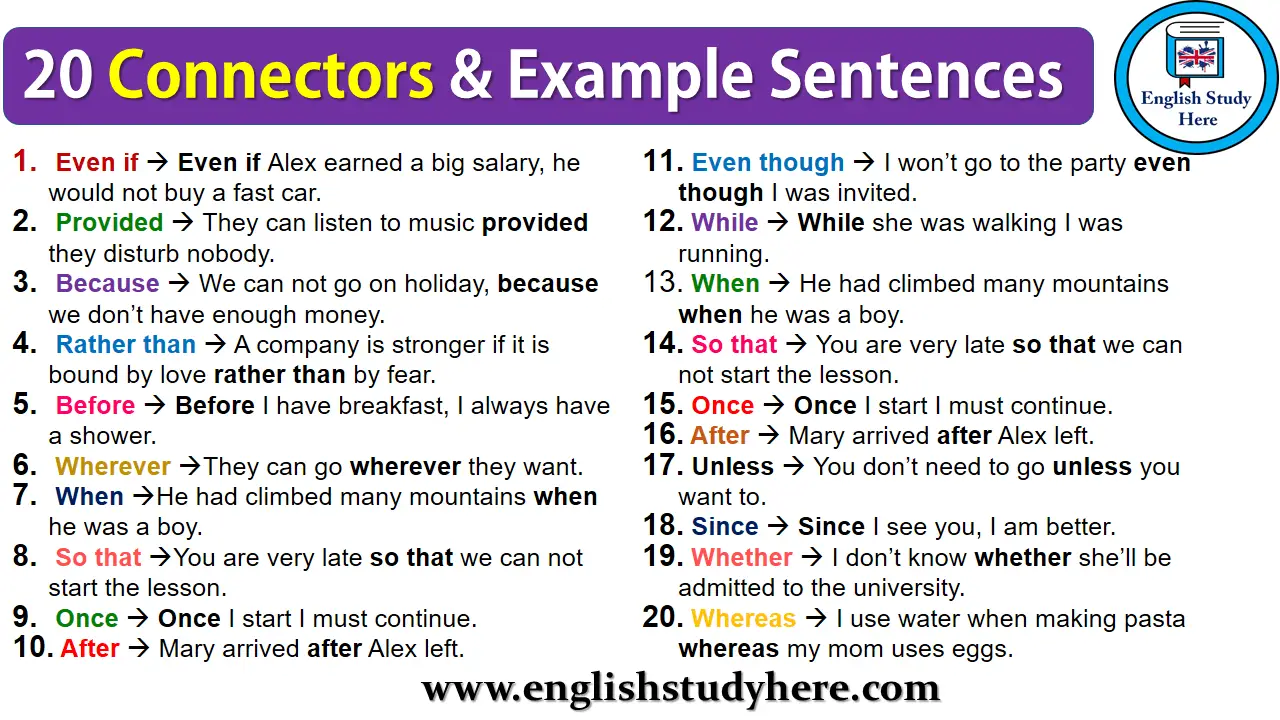
👉 SIMILARITY
1. LIKEWISE
- You can’t give your phone number to every man who asks for it. Likewise, you can’t go out with everyone who fancies you.
2. SIMILARLY
- You’re not allowed to use your phone here. Similarly, you have to switch it off when you’re in the library.
3. CORRESPONDINGLY
- She’s an excellent photographer. Correspondingly, her paintings are works of art.
4. IN THE SAME WAY
- Cutting down on sugar will help you lose weight. In the same way, doing more exercise will help you get rid of a few kilos.
- I want to talk to Prince Harry when I’m in England. Also, I want to meet his sister-in-law.
Read more: Difference between COMPARED TO and COMPARED WITH
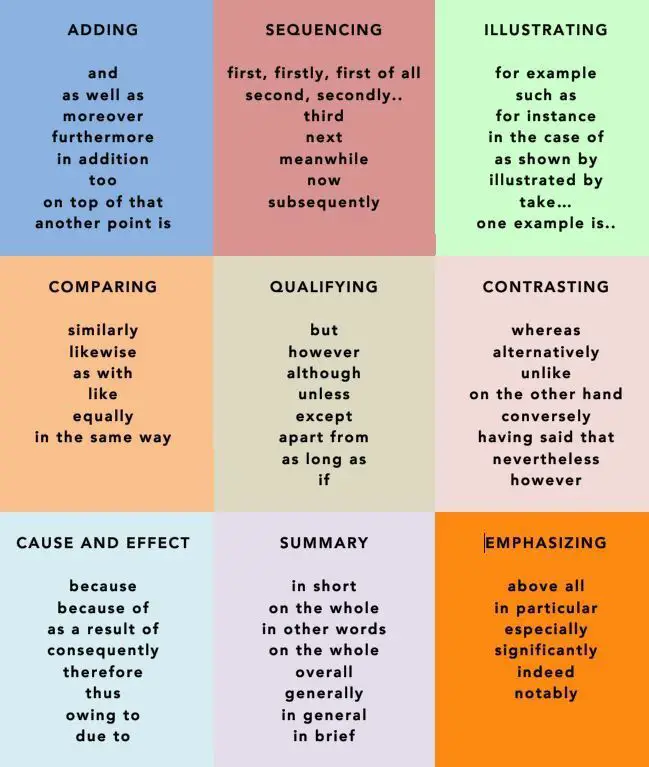
1. AS A RESULT
- I’ve done a pranic healing course. As a result, I’ve been able to cure my neighbour’s sick cat.
2. AS A CONSEQUENCE
- Zack has skipped school on many occasions. As a consequence, he’s failed his French test.
3. THEREFORE
- We’re going to experience some meteor showers in the next few days. Therefore, the number of miraculous self-healings will rise.
- You didn’t tell me you wanted to come. Thus, we won’t be taking you with us.
5. ACCORDINGLY
- Plenty of tourists visit the area in summer. Accordingly, selling hand-made objects is the main source of income for locals.
Read more: 6 Ways to Improve Your English Writing Skills

👉 SEQUENCING
1. FIRST, FIRSTLY, FIRST OF ALL, IN THE FIRST PLACE
- First of all, I’d like to talk about the benefits of having a pet pig.
2. TO BEGIN WITH
- To begin with, pet pigs are cleaner than dogs.
3. FOR ONE THING
- For one thing, they’re completely loyal to their owners.
4. SECOND, SECONDLY, IN THE SECOND PLACE
- Secondly, their impressive numeracy skills must be mentioned.
5. FOR ANOTHER THING
- For another thing, you might want to consider how cute they look in pyjamas.
6. THIRD, THIRDLY, IN THE THIRD PLACE
- In the third place, you can always count on your pet pig to perform some tricks for you when you’d like to impress a pretty girl.
- Also, they don’t eat much.
- Besides not eating much, they won’t ever chew on your electric cords.
9. IN ADDITION
- In addition, they can be taught to feed themselves if you allow them access to your pantry.
10. FURTHERMORE
- Furthermore, they make wonderful walking buddies.
11. MOREOVER
- Moreover, they’ll show you the way home when you’re drunk.
12. FINALLY
- Finally, pet pigs are fantastic guards. No burglar would ever have the heart to hurt a pet pig.
13. LAST, LASTLY, LAST OF ALL
- Lastly, your reputation as an eccentric will rapidly grow in the neighbourhood if you’re seen walking a pet pig on a leash every morning.
Read more: 18 Powerful Websites to Improve Your Writing Skills in English

👉 ORDER OF IMPORTANCE
1. MOST IMPORTANTLY
- I’d like to talk to you about how to keep calm at your workplace. Most importantly, never go to the canteen while your boss is there.
2. PRIMARILY
- You’ll have to focus on your immediate surroundings. Primarily, on your computer screen.
3. ABOVE ALL
- Above all, don’t ever look up from your notes when people are around.
4. MOST SIGNIFICANTLY
- Most significantly, avoid eye-contact at all costs.
5. ESSENTIALLY, BASICALLY (usually spoken)
- How can I put this? Essentially, having an affair with one of your colleagues should be the last thing on your mind.
Read more: 7 Special Apps To Quickly Improve Your Typing Speed
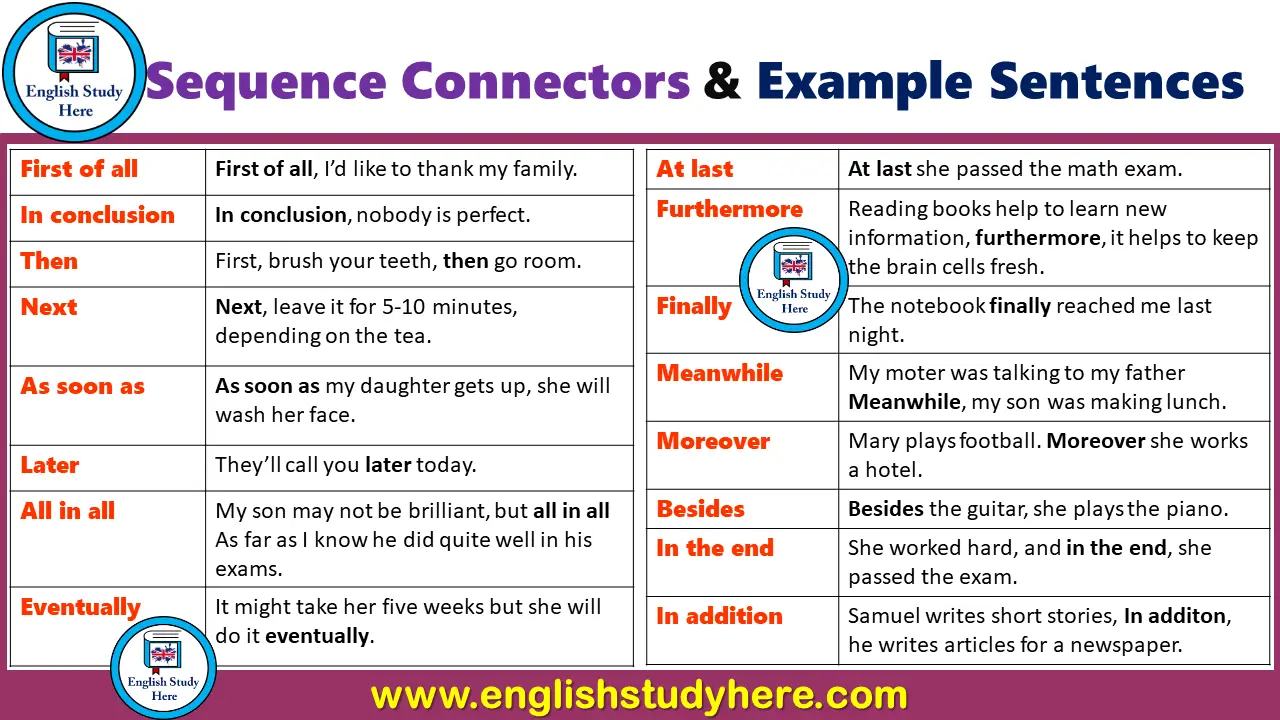
👉 PARTICULARIZATION
1. IN PARTICULAR, PARTICULARLY
- Nearly a third of marriages end in divorce. In particular, it’s middle-aged couples that yearn for much more from life.
2. MORE SPECIFICALLY
- Couples tend to argue about financial issues. More specifically, they argue when one of them is out of work.
Read more: How Many Types of Expressions there are in English?
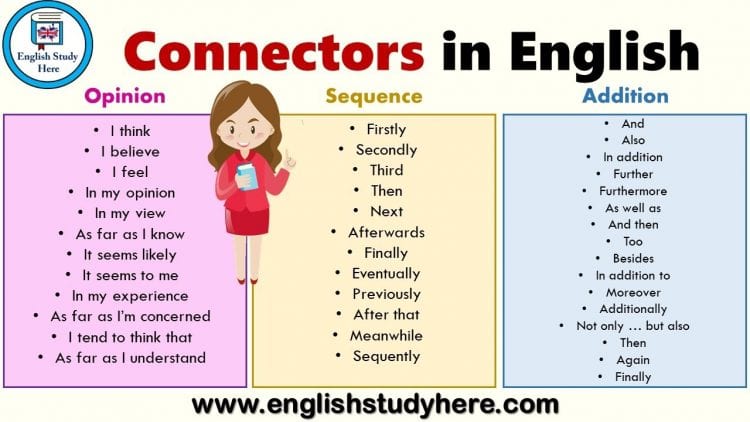
👉 EXAMPLIFICATION
1. FOR EXAMPLE
- To solve this problem, you might want to try making small gestures. For example, making your spouse’s favourite meal for dinner or giving him a massage after a tiring day.
2. FOR INSTANCE
- Appreciate the small things your spouse does for you. For instance, leave thank-you notes for them every now and then.
3. TO ILLUSTRATE
- Misunderstandings can be highly destructive. To illustrate, if your spouse sees you with a friend of the opposite sex in a café, he might not understand why he hasn’t been invited and demand an explanation.
Read more: Other ways to say for example?
👉 EXPLANATION
1. THAT IS TO SAY, THAT IS
- Keep romance alive. That is to say, don’t let your lovelife fall into routine.
- I have a very good reason for not trusting my ex. Namely, he’s a convicted felon.
3. IN OTHER WORDS
- Don’t be unsociable. In other words, go out and make some friends.
4. PUT DIFFERENTLY
- John has managed to get over Jane. Put differently, he’s started seeing other women.
Read more: 10 Common English Expressions with Explanation (Video)
👉 EMPHASISING
1. AS A MATTER OF FACT
- I love sleeping with my pet pig. As a matter of fact, I can’t fall asleep unless he’s in my bed.
- I told them not to invite Rachel to the party. In fact, I was the only person who saw what a party pooper she really was.
3. ACTUALLY
- I think it would be a good idea to send her some flowers. Actually, you should get her a hundred orchids.
- He may be the best-dressed man around. Indeed, he has a really good taste in fashion.
Read more: Essential Academic Writing Examples and Phrases!
👉 FOCUSING AND LINKING
1. AS FOR (often suggests disinterest or dislike)
- I’m going to Janet’s party at the weekend. As for Mary’s, I think I’ll pass.
2. WITH RESPECT TO
- Starting your own IT company may be the one of the best things you can do right now. With respect to opening a pet shop, it’s hard to say the same thing.
3. REGARDING
- Start your day with making the most important phone calls. Regarding emails, you might put them off until later.
4. WITH REGARD TO
- With regard to handling complaints, you might want to keep in mind that your customers are always right.
5. AS REGARDS
- Working from home has many advantages. As regards disadvantages, it might be difficult to keep your cat off your keyboard.
6. TALKING OF
- Talking of cats, you can’t trust them to keep you company when you need it. They’re quite selfish creatures.
7. AS FAR AS … CONCERNED
- As far as dogs are concerned, they might give you a chance to get up from your desk and get some exercise during the day.
Read more: English Grammar: Sentence Structure in English
👉 CONCLUSION
1. IN CONCLUSION
- In conclusion, it may be said that pigs make the best pets.
2. IN BRIEF
- Meeting my boss at the pub was an interesting experience. In brief, it was a disaster.
3. IN SUMMARY
- In summary, it may not be the best idea to frequent the same pubs as your boss.
4. TO SUM UP
- To sum up, some people are better suited to working from home than others.
5. ALL IN ALL
- All in all, you have to make sure both you and your customers are satisfied with your work.
Read more: What are the other ways to say in conclusion ?
👉 CORRECTION
- I thought it was a good idea to get a ferret. Rather, it had always been my dream to get one.
2. TO BE MORE PRECISE
- You might want to change a few things. To be more precise, I think you should start again from scratch.
Read more: Best English Grammar and Spelling Checkers Online
1. AT FIRST
- It wasn’t a piece of cake to learn English. At first, I couldn’t pronounce all the words correctly.
- Then, I couldn’t spell all the words correctly.
3. AFTERWARDS
- Afterwards, I had a hard time understanding the tenses.
- Later, I couldn’t memorize phrasal verbs and idioms.
5. IN THE MEANTIME
- In the meantime, I was getting some help from MyEnglishTeacher .
6. MEANWHILE
- Meanwhile, I was enjoying my skype lessons more and more.
Read more: A Visual List of 100 English IDIOMS FOR TIME with Examples
👉 DISMISSAL
(of what was said before)
- I couldn’t get my head around the Passive Voice. Anyway, I don’t think it’s important to use it all the time.
- Anyhow, I’ve just decided to learn Russian next.
3. AT ANY RATE
- At any rate, I don’t want to become a simultaneous interpreter in five languages.
Linking Words Quiz › TEST YOURSELF
- To begin with
- For one thing
- In other words
- Along those lines
- On the other hand
- All the same
- Firstly / Secondly
- Soon / After
- Now / Later
- Before / After
- As for / treated
- However / asked
- As far as / concerned
- As far as / thinking
- On the other side
- Despite this
- Another / like
- Just as / so too
- Likewise / equally
- In the back
- On top of that
- Subsequently
- Nevertheless
- In particular
- Furthermore
- Accordingly
- As a result
- In contrast
- At any rate
👉 Connectors Synonyms
Connectors are not only used in grammar . Connectors are things that are used to connect or tether two, or more, things together. There are many different synonyms for connectors:
- Bond, coupling, joint, link, adapter, clamp, fastener, junction, tie, terminal, plug, fitting, splicing, fastener, sleeve, etc.
👉 Sentence Definition
A sentence is a set of words that forms a coherent and complete thought and message. This means that a sentence says something concrete. It has to be structured and logical in order for the sentence to be correct.
Sentences are made up of various parts , such as: nouns, verbs, adjectives, pronouns, articles, etc. Within a sentence, there are parts that relate the thought and message , such as: subject, predicate, object, phrase, punctuation, etc. Each of these parts is important for a sentence to be complete.
Through sentences we tell other people what we think, feel, or what we want to do . In order to relate those thoughts we string together words into groups. These finally relate our message to other people and the world.
There are four different types of sentences , and each has its own specific goal and structure. These types are: declarative, imperative, interrogative, and exclamatory.
RELATED ARTICLES MORE FROM AUTHOR

Complex Sentences and Compound Complex Sentences in English

50+ Best Online Quiz Makers for You!

Examples of Silent Letter L

Find the Perfect Film for your Mood with our “What Movie Should I Watch” Quiz!
![Spot Parts of Speech [Grammar Quiz] parts of speech quiz](https://www.myenglishteacher.eu/blog/wp-content/uploads/2023/01/parts-of-speech-quiz-218x150.jpeg)
Spot Parts of Speech [Grammar Quiz]
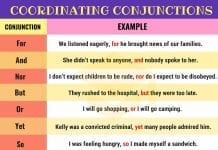
FANBOYS GRAMMAR 😃🥳😜 7 Coordinating Conjunctions with Examples

One of the best posts I’ve ever read here. Congrats!!
It’s awesome so useful and practical thanks a million. I’m gonna share it with my friends.

I liked it so much. Thank you Mr/Mrs tutor.

Indeed, it refreshing our vocabulary

Thank you very much!! This must be by far one of the greatest post I’ve seen to improve my writing skills and expand the vocabulary of connectors. Therefore 😉 , I will add to my list of resources and share with my friends
So glad! 😃❤️

Thanks a ton, teacher!
Sure, anytime!

Thankyou soo muchhh for this usefull info..

Thank you so much for this useful

Excellent exercise
My great thanks
It is highly appreciated

Thanks a lot
you are welcome!

Helpful post! You have nicely divided all the connectors in group like result, time, explanation, conclusion …. and present them with accurate examples. Everything is easy to grab. Thanks for sharing this rare post.
Thank you so much Mohan! I’m glad you loved it!

Thanks for this usefull lessons. They are highly educattive.
Thank you so much!

So far this is the best post I’ve ever seen. I find it hard to use those connectors in statements. I can speak basic English and sometimes not concise with my statements because I’m not good in using connectors in English. Thank you for this great post. It will help a lot of speakers to become articulate with the language.
Thank you so much Oscar for your feedback!

Thanks millions for posting the tables of connecting sentences. Have a great life

I love this array of connectors. Great selections to fit our lesson. Thank you to all who are part of this website and contributors. God bless you all!
Thank you so much Mica.

Linker words, also known as sentence connectors, play a crucial role in connecting phrases, sentences, and paragraphs for enhanced coherence in writing. In terms of contrast, words like “however,” “in contrast,” and “nevertheless” emphasize opposing ideas. For expressing similarity, “likewise,” “similarly,” and “correspondingly” are effective. Result-oriented connectors include “as a result,” “therefore,” and “accordingly,” signaling outcomes or consequences. These words help create a logical flow within text, ensuring a smooth transition between ideas. Whether highlighting differences, similarities, or results, these connectors contribute to cohesive and well-structured writing, facilitating the comprehension of complex information.

Its very useful , thank you.
Thank you so much Himali!
MOST POPULAR

👉 A BIG List of Prefixes and Suffixes and Their Meanings

200 Phrases for saying THANK YOU in any situation!

Formal and Informal Email Phrases – from Greetings to Closing Phrases!

80 In Conclusion Examples! + Translation

90 Names of Baby Animals and Their Parents
![Types of Adverb 🦠 Adverb Examples [All You Need] adverbs](https://www.myenglishteacher.eu/blog/wp-content/uploads/2018/07/adverbs-100x70.jpg)
Types of Adverb 🦠 Adverb Examples [All You Need]

Talk to Strangers / Free Chat Rooms

English Level Test

6 Ways to Immediately Improve Your English Communication Skills

50 Creative Ways to Say Happy Birthday: My Top Picks

What does TBH mean? (TBH full form) on Facebook, Instagram, Texting

25 Ways to Say “Keep Up The Good Work” 💪 &...
Stay connected, editor picks.

Supposition Meaning

Summary of how Components of Health are related to Wellness

Understanding the Extroverted Introvert
Popular posts, popular category.
- Q&A 2439
- English Vocabulary 624
- English Vocabulary Dictionary 363
- English Grammar 200
- Synonyms 147
- Infographics 109
- Collocations 105
- Learn English 81
- English Idioms 69
- Privacy Policy
- Terms & Conditions
33 Transition Words and Phrases
Transitional terms give writers the opportunity to prepare readers for a new idea, connecting the previous sentence to the next one.
Many transitional words are nearly synonymous: words that broadly indicate that “this follows logically from the preceding” include accordingly, therefore, and consequently . Words that mean “in addition to” include moreover, besides, and further . Words that mean “contrary to what was just stated” include however, nevertheless , and nonetheless .
as a result : THEREFORE : CONSEQUENTLY
The executive’s flight was delayed and they accordingly arrived late.
in or by way of addition : FURTHERMORE
The mountain has many marked hiking trails; additionally, there are several unmarked trails that lead to the summit.
at a later or succeeding time : SUBSEQUENTLY, THEREAFTER
Afterward, she got a promotion.
even though : ALTHOUGH
She appeared as a guest star on the show, albeit briefly.
in spite of the fact that : even though —used when making a statement that differs from or contrasts with a statement you have just made
They are good friends, although they don't see each other very often.
in addition to what has been said : MOREOVER, FURTHERMORE
I can't go, and besides, I wouldn't go if I could.
as a result : in view of the foregoing : ACCORDINGLY
The words are often confused and are consequently misused.
in a contrasting or opposite way —used to introduce a statement that contrasts with a previous statement or presents a differing interpretation or possibility
Large objects appear to be closer. Conversely, small objects seem farther away.
used to introduce a statement that is somehow different from what has just been said
These problems are not as bad as they were. Even so, there is much more work to be done.
used as a stronger way to say "though" or "although"
I'm planning to go even though it may rain.
in addition : MOREOVER
I had some money to invest, and, further, I realized that the risk was small.
in addition to what precedes : BESIDES —used to introduce a statement that supports or adds to a previous statement
These findings seem plausible. Furthermore, several studies have confirmed them.
because of a preceding fact or premise : for this reason : THEREFORE
He was a newcomer and hence had no close friends here.
from this point on : starting now
She announced that henceforth she would be running the company.
in spite of that : on the other hand —used when you are saying something that is different from or contrasts with a previous statement
I'd like to go; however, I'd better not.
as something more : BESIDES —used for adding information to a statement
The city has the largest population in the country and in addition is a major shipping port.
all things considered : as a matter of fact —used when making a statement that adds to or strengthens a previous statement
He likes to have things his own way; indeed, he can be very stubborn.
for fear that —often used after an expression denoting fear or apprehension
He was concerned lest anyone think that he was guilty.
in addition : ALSO —often used to introduce a statement that adds to and is related to a previous statement
She is an acclaimed painter who is likewise a sculptor.
at or during the same time : in the meantime
You can set the table. Meanwhile, I'll start making dinner.
BESIDES, FURTHER : in addition to what has been said —used to introduce a statement that supports or adds to a previous statement
It probably wouldn't work. Moreover, it would be very expensive to try it.
in spite of that : HOWEVER
It was a predictable, but nevertheless funny, story.
in spite of what has just been said : NEVERTHELESS
The hike was difficult, but fun nonetheless.
without being prevented by (something) : despite—used to say that something happens or is true even though there is something that might prevent it from happening or being true
Notwithstanding their youth and inexperience, the team won the championship.
if not : or else
Finish your dinner. Otherwise, you won't get any dessert.
more correctly speaking —used to introduce a statement that corrects what you have just said
We can take the car, or rather, the van.
in spite of that —used to say that something happens or is true even though there is something that might prevent it from happening or being true
I tried again and still I failed.
by that : by that means
He signed the contract, thereby forfeiting his right to the property.
for that reason : because of that
This tablet is thin and light and therefore very convenient to carry around.
immediately after that
The committee reviewed the documents and thereupon decided to accept the proposal.
because of this or that : HENCE, CONSEQUENTLY
This detergent is highly concentrated and thus you will need to dilute it.
while on the contrary —used to make a statement that describes how two people, groups, etc., are different
Some of these species have flourished, whereas others have struggled.
NEVERTHELESS, HOWEVER —used to introduce a statement that adds something to a previous statement and usually contrasts with it in some way
It was pouring rain out, yet his clothes didn’t seem very wet.
Word of the Day
See Definitions and Examples »
Get Word of the Day daily email!
Games & Quizzes

Usage Notes
Prepositions, ending a sentence with, is 'irregardless' a real word, 8 more grammar terms you used to know: special verb edition, point of view: it's personal, 31 useful rhetorical devices, grammar & usage, primary and caucus: what is the difference, words commonly mispronounced, merriam-webster’s great big list of words you love to hate, more commonly misspelled words, your vs. you're: how to use them correctly, 12 words for signs of spring, 12 more bird names that sound like insults (and sometimes are), 13 unusually long english words, the words of the week - may 10, a great big list of bread words.
- Support Sites
Extended Essay Support Site
Connectives.
There are words in the English language that act like glue to help you stick your sentences together and show the relationships between the ideas that you want to express. These words are called 'connectives' (or 'linking words'). Connectives help your essay 'flow' and read more coherently. More specifically, connectives help you:
- illustrate a point,
- compare and contrast ideas,
- sequence ideas,
- conclude or summarise ideas,
- show a causal relatioship.
Are you in the process of proof-reading your essay? See if you can add a few of these words, especially at the beginnings of sentences.
- as a result of
- at the same time
- consequently
- echoing this
- even though
- firstly... secondly...
- following on from this
- for instance / for example
- for this reason
- furthermore
- in addition
- in conclusion
- in spite of
- in the same vein
- nevertheless
- nonetheless
- not only... but also...
- notwithstanding
- now we look at
- on the one hand
- on the other hand
- one reason why...
- International
- Schools directory
- Resources Jobs Schools directory News Search
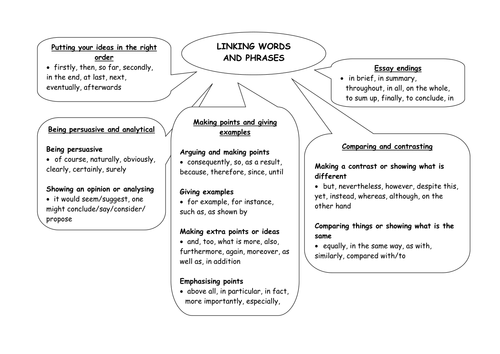
Linking Words and Phrases: connectives in essays
Subject: English
Age range: 14-16
Resource type: Worksheet/Activity
Last updated
22 February 2018
- Share through email
- Share through twitter
- Share through linkedin
- Share through facebook
- Share through pinterest

A resourse that is aimed at helping pupils structure their essay correctly. It provides lists of connectives that students can use to provide structure, sum up, compare or contrast, persuade or analyse in essays.
Tes classic free licence
Your rating is required to reflect your happiness.
It's good to leave some feedback.
Something went wrong, please try again later.
stuartgsmit
Many thanks. I will use this in the New year.
Empty reply does not make any sense for the end user
Useful for writing plans, improving power of speech, etc.
Handy for talking about informal connectives.<br />
Report this resource to let us know if it violates our terms and conditions. Our customer service team will review your report and will be in touch.
Not quite what you were looking for? Search by keyword to find the right resource:
Find anything you save across the site in your account

In the campus protests over the war in Gaza, language and rhetoric are—as they have always been when it comes to Israel and Palestine—weapons of mass destruction.
By Zadie Smith
A philosophy without a politics is common enough. Aesthetes, ethicists, novelists—all may be easily critiqued and found wanting on this basis. But there is also the danger of a politics without a philosophy. A politics unmoored, unprincipled, which holds as its most fundamental commitment its own perpetuation. A Realpolitik that believes itself too subtle—or too pragmatic—to deal with such ethical platitudes as thou shalt not kill. Or: rape is a crime, everywhere and always. But sometimes ethical philosophy reënters the arena, as is happening right now on college campuses all over America. I understand the ethics underpinning the protests to be based on two widely recognized principles:
There is an ethical duty to express solidarity with the weak in any situation that involves oppressive power.
If the machinery of oppressive power is to be trained on the weak, then there is a duty to stop the gears by any means necessary.
The first principle sometimes takes the “weak” to mean “whoever has the least power,” and sometimes “whoever suffers most,” but most often a combination of both. The second principle, meanwhile, may be used to defend revolutionary violence, although this interpretation has just as often been repudiated by pacifistic radicals, among whom two of the most famous are, of course, Mahatma Gandhi and Martin Luther King, Jr . In the pacifist’s interpretation, the body that we must place between the gears is not that of our enemy but our own. In doing this, we may pay the ultimate price with our actual bodies, in the non-metaphorical sense. More usually, the risk is to our livelihoods, our reputations, our futures. Before these most recent campus protests began, we had an example of this kind of action in the climate movement. For several years now, many people have been protesting the economic and political machinery that perpetuates climate change, by blocking roads, throwing paint, interrupting plays, and committing many other arrestable offenses that can appear ridiculous to skeptics (or, at the very least, performative), but which in truth represent a level of personal sacrifice unimaginable to many of us.
I experienced this not long ago while participating in an XR climate rally in London. When it came to the point in the proceedings where I was asked by my fellow-protesters whether I’d be willing to commit an arrestable offense—one that would likely lead to a conviction and thus make travelling to the United States difficult or even impossible—I’m ashamed to say that I declined that offer. Turns out, I could not give up my relationship with New York City for the future of the planet. I’d just about managed to stop buying plastic bottles (except when very thirsty) and was trying to fly less. But never to see New York again? What pitiful ethical creatures we are (I am)! Falling at the first hurdle! Anyone who finds themselves rolling their eyes at any young person willing to put their own future into jeopardy for an ethical principle should ask themselves where the limits of their own commitments lie—also whether they’ve bought a plastic bottle or booked a flight recently. A humbling inquiry.
It is difficult to look at the recent Columbia University protests in particular without being reminded of the campus protests of the nineteen-sixties and seventies, some of which happened on the very same lawns. At that time, a cynical political class was forced to observe the spectacle of its own privileged youth standing in solidarity with the weakest historical actors of the moment, a group that included, but was not restricted to, African Americans and the Vietnamese. By placing such people within their ethical zone of interest, young Americans risked both their own academic and personal futures and—in the infamous case of Kent State—their lives. I imagine that the students at Columbia—and protesters on other campuses—fully intend this echo, and, in their unequivocal demand for both a ceasefire and financial divestment from this terrible war, to a certain extent they have achieved it.
But, when I open newspapers and see students dismissing the idea that some of their fellow-students feel, at this particular moment, unsafe on campus, or arguing that such a feeling is simply not worth attending to, given the magnitude of what is occurring in Gaza, I find such sentiments cynical and unworthy of this movement. For it may well be—within the ethical zone of interest that is a campus, which was not so long ago defined as a safe space, delineated by the boundary of a generation’s ethical ideas— it may well be that a Jewish student walking past the tents, who finds herself referred to as a Zionist, and then is warned to keep her distance, is, in that moment, the weakest participant in the zone. If the concept of safety is foundational to these students’ ethical philosophy (as I take it to be), and, if the protests are committed to reinserting ethical principles into a cynical and corrupt politics, it is not right to divest from these same ethics at the very moment they come into conflict with other imperatives. The point of a foundational ethics is that it is not contingent but foundational. That is precisely its challenge to a corrupt politics.
Practicing our ethics in the real world involves a constant testing of them, a recognition that our zones of ethical interest have no fixed boundaries and may need to widen and shrink moment by moment as the situation demands. (Those brave students who—in supporting the ethical necessity of a ceasefire—find themselves at painful odds with family, friends, faith, or community have already made this calculation.) This flexibility can also have the positive long-term political effect of allowing us to comprehend that, although our duty to the weakest is permanent, the role of “the weakest” is not an existential matter independent of time and space but, rather, a contingent situation, continually subject to change. By contrast, there is a dangerous rigidity to be found in the idea that concern for the dreadful situation of the hostages is somehow in opposition to, or incompatible with, the demand for a ceasefire. Surely a ceasefire—as well as being an ethical necessity—is also in the immediate absolute interest of the hostages, a fact that cannot be erased by tearing their posters off walls.
Part of the significance of a student protest is the ways in which it gives young people the opportunity to insist upon an ethical principle while still being, comparatively speaking, a more rational force than the supposed adults in the room, against whose crazed magical thinking they have been forced to define themselves. The equality of all human life was never a self-evident truth in racially segregated America. There was no way to “win” in Vietnam. Hamas will not be “eliminated.” The more than seven million Jewish human beings who live in the gap between the river and the sea will not simply vanish because you think that they should. All of that is just rhetoric. Words. Cathartic to chant, perhaps, but essentially meaningless. A ceasefire, meanwhile, is both a potential reality and an ethical necessity. The monstrous and brutal mass murder of more than eleven hundred people, the majority of them civilians, dozens of them children, on October 7th, has been followed by the monstrous and brutal mass murder (at the time of writing) of a reported fourteen thousand five hundred children. And many more human beings besides, but it’s impossible not to notice that the sort of people who take at face value phrases like “surgical strikes” and “controlled military operation” sometimes need to look at and/or think about dead children specifically in order to refocus their minds on reality.
To send the police in to arrest young people peacefully insisting upon a ceasefire represents a moral injury to us all. To do it with violence is a scandal. How could they do less than protest, in this moment? They are putting their own bodies into the machine. They deserve our support and praise. As to which postwar political arrangement any of these students may favor, and on what basis they favor it—that is all an argument for the day after a ceasefire. One state, two states, river to the sea—in my view, their views have no real weight in this particular moment, or very little weight next to the significance of their collective action, which (if I understand it correctly) is focussed on stopping the flow of money that is funding bloody murder, and calling for a ceasefire, the political euphemism that we use to mark the end of bloody murder. After a ceasefire, the criminal events of the past seven months should be tried and judged, and the infinitely difficult business of creating just, humane, and habitable political structures in the region must begin anew. Right now: ceasefire. And, as we make this demand, we might remind ourselves that a ceasefire is not, primarily, a political demand. Primarily, it is an ethical one.
But it is in the nature of the political that we cannot even attend to such ethical imperatives unless we first know the political position of whoever is speaking. (“Where do you stand on Israel/Palestine?”) In these constructed narratives, there are always a series of shibboleths, that is, phrases that can’t be said, or, conversely, phrases that must be said. Once these words or phrases have been spoken ( river to the sea, existential threat, right to defend, one state, two states, Zionist, colonialist, imperialist, terrorist ) and one’s positionality established, then and only then will the ethics of the question be attended to (or absolutely ignored). The objection may be raised at this point that I am behaving like a novelist, expressing a philosophy without a politics, or making some rarefied point about language and rhetoric while people commit bloody murder. This would normally be my own view, but, in the case of Israel/Palestine, language and rhetoric are and always have been weapons of mass destruction.
It is in fact perhaps the most acute example in the world of the use of words to justify bloody murder, to flatten and erase unbelievably labyrinthine histories, and to deliver the atavistic pleasure of violent simplicity to the many people who seem to believe that merely by saying something they make it so. It is no doubt a great relief to say the word “Hamas” as if it purely and solely described a terrorist entity. A great relief to say “There is no such thing as the Palestinian people” as they stand in front of you. A great relief to say “Zionist colonialist state” and accept those three words as a full and unimpeachable definition of the state of Israel, not only under the disastrous leadership of Benjamin Netanyahu but at every stage of its long and complex history, and also to hear them as a perfectly sufficient description of every man, woman, and child who has ever lived in Israel or happened to find themselves born within it. It is perhaps because we know these simplifications to be impossible that we insist upon them so passionately. They are shibboleths; they describe a people, by defining them against other people—but the people being described are ourselves. The person who says “We must eliminate Hamas” says this not necessarily because she thinks this is a possible outcome on this earth but because this sentence is the shibboleth that marks her membership in the community that says that. The person who uses the word “Zionist” as if that word were an unchanged and unchangeable monolith, meaning exactly the same thing in 2024 and 1948 as it meant in 1890 or 1901 or 1920—that person does not so much bring definitive clarity to the entangled history of Jews and Palestinians as they successfully and soothingly draw a line to mark their own zone of interest and where it ends. And while we all talk, carefully curating our shibboleths, presenting them to others and waiting for them to reveal themselves as with us or against us—while we do all that, bloody murder.
And now here we are, almost at the end of this little stream of words. We’ve arrived at the point at which I must state clearly “where I stand on the issue,” that is, which particular political settlement should, in my own, personal view, occur on the other side of a ceasefire. This is the point wherein—by my stating of a position—you are at once liberated into the simple pleasure of placing me firmly on one side or the other, putting me over there with those who lisp or those who don’t, with the Ephraimites, or with the people of Gilead. Yes, this is the point at which I stake my rhetorical flag in that fantastical, linguistical, conceptual, unreal place—built with words—where rapes are minimized as needs be, and the definition of genocide quibbled over, where the killing of babies is denied, and the precision of drones glorified, where histories are reconsidered or rewritten or analogized or simply ignored, and “Jew” and “colonialist” are synonymous, and “Palestinian” and “terrorist” are synonymous, and language is your accomplice and alibi in all of it. Language euphemized, instrumentalized, and abused, put to work for your cause and only for your cause, so that it does exactly and only what you want it to do. Let me make it easy for you. Put me wherever you want: misguided socialist, toothless humanist, naïve novelist, useful idiot, apologist, denier, ally, contrarian, collaborator, traitor, inexcusable coward. It is my view that my personal views have no more weight than an ear of corn in this particular essay. The only thing that has any weight in this particular essay is the dead. ♦
New Yorker Favorites
The day the dinosaurs died .
What if you started itching— and couldn’t stop ?
How a notorious gangster was exposed by his own sister .
Woodstock was overrated .
Diana Nyad’s hundred-and-eleven-mile swim .
Photo Booth: Deana Lawson’s hyper-staged portraits of Black love .
Fiction by Roald Dahl: “The Landlady”
Sign up for our daily newsletter to receive the best stories from The New Yorker .
By signing up, you agree to our User Agreement and Privacy Policy & Cookie Statement . This site is protected by reCAPTCHA and the Google Privacy Policy and Terms of Service apply.

By Susan B. Glasser

By Keeanga-Yamahtta Taylor

By Jay Caspian Kang

By David Remnick
A Fresh Perspective on “Brave New World” by Aldous Huxley
This essay about Aldous Huxley’s “Brave New World” provides an analysis of the dystopian themes and societal critiques presented in the novel. It discusses the futuristic setting where the World State controls every aspect of life, categorizing citizens into castes and eliminating individuality through conditioning and the drug soma. The narrative follows characters like Bernard Marx and John the Savage, who challenge the societal norms and expose the cost of maintaining such a controlled utopia. The essay explores the novel’s reflection on contemporary issues like technological control, loss of personal freedom, and the ethical dilemmas of progress, suggesting that Huxley’s work remains relevant today as it questions the balance between societal stability and personal freedom. Through “Brave New World,” the essay prompts readers to consider the moral implications of our own societal choices and the future we are navigating.
How it works
In his dystopian novel “Brave New World,” Aldous Huxley presents a terrifying picture of a society in which the government has painstakingly planned every aspect of society to guarantee stability and happiness for all. First published in 1932, the book continues to be a key work of dystopian literature, addressing issues of control, technology, and the willingness to give up personal freedom in the name of social harmony. As we delve deeper into Huxley’s universe, we find a civilization that at first glance could seem utopian—all disputes and discomforts are supposedly eliminated—but a closer look exposes a troubling price for this peaceful way of life.
The futuristic London of “Brave New World” is ruled by the World State, which assumes the appearance of kindness but really has an iron grip. From birth, the residents are socialized into classes that range from the highly intelligent Alphas to the lowly Epsilons who work as laborers. This indoctrination permeates every aspect of life, as individuality is reduced to a historical idea and free will is given up for the benefit of the group.
The government ensures compliance through the distribution of soma, a drug that eradicates pain and ensures compliance among the masses, promoting an ethos of “a gramme is better than a damn.” Huxley’s narrative begins to twist when Bernard Marx, an Alpha plus psychologist, feels out of sync with the society he’s supposed to lead. His restlessness leads him to question the foundations of the World State, a curiosity ignited further by his relationship with Lenina Crowne and his interactions with John, a “savage” from an unassimilated reservation in New Mexico.
John, who grew up outside the societal norms of the World State, serves as a poignant contrast to the controlled denizens of the utopia. His presence in London acts as a catalyst, challenging the core tenets of this society. His struggle with the World State’s ethos of consumption, sexual freedom, and emotional suppression brings the philosophical debates to the forefront of the narrative. The tragic arc of John’s character underscores the novel’s central thesis: the loss of human dignity and freedom in the face of technological and governmental control.
Through vivid characterization and a richly imagined world, Huxley critiques contemporary issues of his time, many of which resonate profoundly today. The novel contemplates the impact of advanced science and technology on human values and behaviors, highlighting the dangers of a society willing to sacrifice liberty for perceived security and comfort. It prompts a reflection on the meaning of happiness and the price of progress, questioning whether true contentment requires a balance between freedom and order.
As we reflect on Huxley’s work in the context of modern society, it’s apparent that many of the ethical and philosophical questions he raised remain pertinent. From genetic engineering to the role of government in personal lives, “Brave New World” offers a crucial lens through which to examine the moral implications of our choices. Huxley’s speculative world, with its technological wonders and social stratifications, serves not only as a warning but also as a mirror, reflecting our own struggles with technological advancement and ethical governance.
In summary, “Brave New World” is a pertinent remark on the modern world as well as a relic of dystopian literature. Readers are prompted to consider the future of our civilization by its examination of the human condition, societal expectations, and the frequently hazy boundary between utopia and dystopia. Huxley’s book serves as a timely warning of what happens to us when we let the monetization of human experience determine our future, even while we forge our own daring new paths. It is an engaging investigation on the extent and price that mankind should pay in its quest for the ideal society.
This classic story still functions as a critical analysis of our decisions and goals, demonstrating how a deeper comprehension of a work this complex may enhance not only our enjoyment of literature but also our grasp of society structures and the human mind.
Cite this page
A Fresh Perspective on "Brave New World" by Aldous Huxley. (2024, May 12). Retrieved from https://papersowl.com/examples/a-fresh-perspective-on-brave-new-world-by-aldous-huxley/
"A Fresh Perspective on "Brave New World" by Aldous Huxley." PapersOwl.com , 12 May 2024, https://papersowl.com/examples/a-fresh-perspective-on-brave-new-world-by-aldous-huxley/
PapersOwl.com. (2024). A Fresh Perspective on "Brave New World" by Aldous Huxley . [Online]. Available at: https://papersowl.com/examples/a-fresh-perspective-on-brave-new-world-by-aldous-huxley/ [Accessed: 12 May. 2024]
"A Fresh Perspective on "Brave New World" by Aldous Huxley." PapersOwl.com, May 12, 2024. Accessed May 12, 2024. https://papersowl.com/examples/a-fresh-perspective-on-brave-new-world-by-aldous-huxley/
"A Fresh Perspective on "Brave New World" by Aldous Huxley," PapersOwl.com , 12-May-2024. [Online]. Available: https://papersowl.com/examples/a-fresh-perspective-on-brave-new-world-by-aldous-huxley/. [Accessed: 12-May-2024]
PapersOwl.com. (2024). A Fresh Perspective on "Brave New World" by Aldous Huxley . [Online]. Available at: https://papersowl.com/examples/a-fresh-perspective-on-brave-new-world-by-aldous-huxley/ [Accessed: 12-May-2024]
Don't let plagiarism ruin your grade
Hire a writer to get a unique paper crafted to your needs.

Our writers will help you fix any mistakes and get an A+!
Please check your inbox.
You can order an original essay written according to your instructions.
Trusted by over 1 million students worldwide
1. Tell Us Your Requirements
2. Pick your perfect writer
3. Get Your Paper and Pay
Free All-in-One Office Suite with PDF Editor
Edit Word, Excel, and PPT for FREE.
Read, edit, and convert PDFs with the powerful PDF toolkit.
Microsoft-like interface, easy to use.
Windows • MacOS • Linux • iOS • Android

Select areas that need to improve
- Didn't match my interface
- Too technical or incomprehensible
- Incorrect operation instructions
- Incomplete instructions on this function
Fields marked * are required please
Please leave your suggestions below
- Quick Tutorials
- Practical Skills
How to Use Track Changes in Word for Your Essay? [For Students]
My essays and assignments were far from perfect, but I managed to get through them thanks to teachers who pointed out my mistakes. After correcting those errors, I had to send the revised versions for review, making sure to highlight where I made changes. If you need to highlight changes in your document to help your teacher or reviewer track your revisions, I'll show you how to track changes in Word for students.
How to Compare and Highlight Differences in Two papers?
Students often share group project documents to collaborate on adding their parts or revising the content. But what if you forgot to enable the "Track Changes" feature? Fortunately, WPS Writer, a free office suite solution, offers a "Compare" tool. This tool allows students to compare the original document with the revised version to track or acknowledge any changes made. The tool is very straightforward, so let's simplify the steps for comparing documents.
Step 1 : Let's open the original or updated document in WPS Writer.
Step 2 : Go to the "Review" tab in the toolbar and click on the "Compare" button.
Step 3 : Select "Compare..." from the drop-down menu.
Step 4 : The Compare dialog will open. First, browse and upload the original and revised documents by clicking on the "Folder" icon.
Step 5 : Once the documents are selected, click on the "More" button for advanced settings.
Step 6 : In the "Comparison settings" section, choose what to include in the comparison.
Step 7 : In the "Show changes" section, select how to view differences and where to display them in the document.
Step 8 : After exploring advanced settings, click "OK" to proceed.
Step 9 : And here we have the comparison details. It appears that my group member decided to remove some words from a passage that I wrote.
Comparing documents is useful in academic settings as it allows you to learn more in a group setting. Just like how I reviewed the changes made by my group members and tried to understand their purpose, which helped me learn from my mistakes. Additionally, comparing documents can help track changes made by group members at a glance, saving time compared to scrolling through the entire document.
Word is a great tool, especially for students who need to write essays. However, if you want to ensure compatibility across devices—whether mobile, Windows, or Mac—WPS Office is a better choice. It's a free office suite that works with all Word document versions and can even convert your papers to PDF without compromising the original formatting.
How to Use Track Changes in Word for Revising Your Essay?
When writing an essay and you want to draw attention to a specific part, especially one that marks a significant change or correction, highlighting is an effective method. By highlighting, you can ensure that your reader or reviewer notices the changes quickly, making it easier to identify key sections of your work. This is particularly useful when collaborating with teachers or peers for feedback and revisions. Follow these steps to learn how to track changes in Word.
Step 1 : Firstly, let's open the report document in WPS Writer to make some revisions.
Step 2 : Now, to remember the changes made, head to the Review tab and click on the "Track Changes" button. Alternatively, use the shortcut key "Ctrl +Shift + E" to activate this feature.
Step 3 : You'll notice the icon changes color from white to gray, indicating that Track Changes is now active.
Step 4 : Scroll down and make changes in the document; added content will be highlighted in a different color.
Step 5 : Similarly, if content is removed, it will be struck through to highlight the changes
Step 6 : To adjust settings like highlight color or author name, click on the small arrow in the "Track Changes" icon.
Step 7 : Now select "Track Changes Options.." to customize the settings.
Step 8 : Here, you can change how content insertion or deletion is highlighted in the "Markup" section.
Step 9 : In the Balloons section, users can choose whether revisions appear inline or in a separate pane on the right side of the WPS Writer interface.
Step 10 : Once changes are made, exit the Track Changes option dialog by clicking "OK".
Step 11 : Furthermore, click on the small arrow in the Track Changes icon and select "Change username".
Step 12 : Here, students can update the username, ensuring it reflects their preference. Sometimes, your nickname may be shown based on your email ID, so it's possible to change it if needed.
As a student, particularly when tackling projects and theses, the ability to track changes over time is crucial. WPS Writer excels in this area. When I receive feedback from instructors, I utilize the "Track Changes" feature. This allows me to easily see their suggestions and incorporate them into my work while retaining a record of the original text. The "Compare" feature comes in handy when collaborating with classmates. It helps us effectively visualize and merge changes made by different team members. Overall, WPS Writer's constant evolution provides a comprehensive set of features and tools that streamline my workflow and simplify academic life.
Use AI Tools to Perfect Your Paper
As a student, you might wish things were a bit less tedious so you could focus on your studies instead of worrying about the tiny details. This is where WPS Office can make a huge difference. It not only saves you from the hassle of manual tasks like formatting and highlighting, but also provides the tools to create, edit, and organize your work efficiently. Whether you're preparing a thesis, crafting an assignment, or writing an essay, WPS Office has you covered.
WPS AI takes this further by offering assistance to correct grammar and spelling errors, ensuring your document looks professional and polished. It can even generate paper outlines and suggest topic ideas, giving you a head start on your assignments. With these capabilities, you can let WPS Office handle the heavy lifting while you concentrate on creating meaningful content. It's an invaluable tool for students who want to focus on the quality of their work without getting bogged down in the technicalities.
To ensure your thesis or assignment is error-free, let's utilize WPS Writer's AI Spell Check feature.
Step 1 : Open your document and activate the "AI Spell Check" option located at the bottom of the screen.
Step 2 : If you see a word or phrase highlighted with a colored line, simply click on it.
Step 3 : A panel for WPS AI Spell Check will appear on the right side, offering suggestions.
Step 4 : Review the suggestions provided and select the most suitable one.
Besides WPS AI Spell check, WPS Writer's AI feature is an excellent tool for tackling projects. It assists in creating detailed outlines, offering valuable assistance from start to finish. Let's delve deeper into its capabilities.
Step 1 : First, open WPS Office and click "New" on the left side.
Step 2 : Then, select "Docs" to start a new document.
Step 3 : Now, click "WPS AI" at the top right.
Step 4 : A panel for WPS AI will appear on the right.
Step 5 : With WPS AI, I usually share project details and let it create an outline for me.
Step 6 : After getting the outline, I review it and make any changes needed. Finally, I click "Insert" to add it to my document and format it the way I like.
Bonus Tips: How to Convert Word to PDF without losing Format
WPS Office goes beyond traditional word processing software. It offers a comprehensive set of PDF tools that empower students to efficiently manage their documents. Fueled by advancements in AI, WPS PDF delivers an increasingly immersive learning experience.
Students can leverage WPS Writer to meticulously format their work. With the seamless conversion to PDF offered by WPS Office, all those formatting efforts are preserved, ensuring a polished final product. Furthermore, the versatile WPS PDF tools allow for further manipulation and management of these documents.
Here's a simple way for students to convert their papers to PDF using WPS Writer:
Step 1 : Open your paper in WPS Writer and click on the Menu button at the top left corner.
Step 2 : Then, select the "Export to PDF" option from the menu.
Step 3 : In the Export to PDF dialog box, choose "Common PDF" from the "Export Type" dropdown, and then click "Export to PDF" to convert your Word document to PDF .
FAQs about Remove Page Breaks in Word
1. can everyone see the tracked changes in word.
Yes, by default, the tracked alterations are visible to all individuals who access the document. However, you have options to control visibility. You can safeguard the tracked changes with a password or limit editing to specific users, ensuring that only authorized individuals can see or modify the tracked modifications. This feature is particularly beneficial for maintaining confidentiality and control over sensitive information within your document.
2. What is the purpose of using track changes in Word for essays?
Tracking changes in Word serves multiple functions when working on essays:
Revision Tracking: It records all modifications made to the document.
Collaboration: It enables collaboration among peers or instructors.
Feedback: It allows others to give feedback on the essay's content and structure.
3. What is the significance of using WPS Office for demonstrating track changes in Word?
Employing WPS Office to demonstrate track changes in Word holds significance due to its compatibility across various devices and operating systems, including mobile phones, Windows PCs, and Mac computers. It ensures that students can effectively engage with the track changes feature regardless of the device they are using.
Highlight And Track Your Change With WPS Office
When you're tracking errors and correcting them in your work, you would want to highlight the changes to ensure your teacher notices and gives you credit for the corrections and of that you must know how to track changes in Word for students. WPS Office is an excellent choice for students, offering intuitive tools to make highlighting and tracking changes simple. It's designed with students in mind, making it easier to get your work done efficiently. Download WPS Office today to streamline your editing process and ensure you earn those extra marks for your efforts.
- 1. How to Do Hanging Indent in Word for Your Essay? [For Students]
- 2. How to set the cell color to change as the data changes?
- 3. How can we close Track Changes
- 4. 10 Best Excel Task List Templates: Track Your Tasks Like a Pro
- 5. How to Turn off Track Changes in WPS Office (Step-by-Step)
- 6. How to Double Space in Word for Your Essay: A Guide for Students
15 years of office industry experience, tech lover and copywriter. Follow me for product reviews, comparisons, and recommendations for new apps and software.
- Share full article
Advertisement
Supported by
Guest Essay
A Year on Ozempic Taught Me We’re Thinking About Obesity All Wrong

By Johann Hari
Mr. Hari is a British journalist and the author of “Magic Pill: The Extraordinary Benefits — and Disturbing Risks — of the New Weight Loss Drugs.”
Ever since I was a teenager, I have dreamed of shedding a lot of weight. So when I shrank from 203 pounds to 161 in a year, I was baffled by my feelings. I was taking Ozempic, and I was haunted by the sense that I was cheating and doing something immoral.
I’m not the only one. In the United States (where I now split my time), over 70 percent of people are overweight or obese, and according to one poll, 47 percent of respondents said they were willing to pay to take the new weight-loss drugs. It’s not hard to see why. They cause users to lose an average of 10 to 20 percent of their body weight, and clinical trials suggest that the next generation of drugs (probably available soon) leads to a 24 percent loss, on average. Yet as more and more people take drugs like Ozempic, Wegovy and Mounjaro, we get more confused as a culture, bombarding anyone in the public eye who takes them with brutal shaming.
This is happening because we are trapped in a set of old stories about what obesity is and the morally acceptable ways to overcome it. But the fact that so many of us are turning to the new weight-loss drugs can be an opportunity to find a way out of that trap of shame and stigma — and to a more truthful story.
In my lifetime, obesity has exploded, from being rare to almost being the norm. I was born in 1979, and by the time I was 21, obesity rates in the United States had more than doubled . They have skyrocketed since. The obvious question is, why? And how do these new weight-loss drugs work? The answer to both lies in one word: satiety. It’s a concept that we don’t use much in everyday life but that we’ve all experienced at some point. It describes the sensation of having had enough and not wanting any more.
The primary reason we have gained weight at a pace unprecedented in human history is that our diets have radically changed in ways that have deeply undermined our ability to feel sated. My father grew up in a village in the Swiss mountains, where he ate fresh, whole foods that had been cooked from scratch and prepared on the day they were eaten. But in the 30 years between his childhood and mine, in the suburbs of London, the nature of food transformed across the Western world. He was horrified to see that almost everything I ate was reheated and heavily processed. The evidence is clear that the kind of food my father grew up eating quickly makes you feel full. But the kind of food I grew up eating, much of which is made in factories, often with artificial chemicals, left me feeling empty and as if I had a hole in my stomach. In a recent study of what American children eat, ultraprocessed food was found to make up 67 percent of their daily diet. This kind of food makes you want to eat more and more. Satiety comes late, if at all.
One scientific experiment — which I have nicknamed Cheesecake Park — seemed to me to crystallize this effect. Paul Kenny, a neuroscientist at Mount Sinai Hospital in New York, grew up in Ireland. After he moved in 2000 to the United States, when he was in his 20s, he gained 30 pounds in two years. He began to wonder if the American diet has some kind of strange effect on our brains and our cravings, so he designed an experiment to test it. He and his colleague Paul Johnson raised a group of rats in a cage and gave them an abundant supply of healthy, balanced rat chow made out of the kind of food rats had been eating for a very long time. The rats would eat it when they were hungry, and then they seemed to feel sated and stopped. They did not become fat.
But then Dr. Kenny and his colleague exposed the rats to an American diet: fried bacon, Snickers bars, cheesecake and other treats. They went crazy for it. The rats would hurl themselves into the cheesecake, gorge themselves and emerge with their faces and whiskers totally slicked with it. They quickly lost almost all interest in the healthy food, and the restraint they used to show around healthy food disappeared. Within six weeks, their obesity rates soared.
After this change, Dr. Kenny and his colleague tweaked the experiment again (in a way that seems cruel to me, a former KFC addict). They took all the processed food away and gave the rats their old healthy diet. Dr. Kenny was confident that they would eat more of it, proving that processed food had expanded their appetites. But something stranger happened. It was as though the rats no longer recognized healthy food as food at all, and they barely ate it. Only when they were starving did they reluctantly start to consume it again.
Though Dr. Kenny’s study was in rats, we can see forms of this behavior everywhere. We are all living in Cheesecake Park — and the satiety-stealing effect of industrially assembled food is evidently what has created the need for these medications. Drugs like Ozempic work precisely by making us feel full. Carel le Roux, a scientist whose research was important to the development of these drugs, says they boost what he and others once called “satiety hormones.”
Once you understand this context, it becomes clear that processed and ultraprocessed food create a raging hole of hunger, and these treatments can repair that hole. Michael Lowe, a professor of psychology at Drexel University who has studied hunger for 40 years, told me the drugs are “an artificial solution to an artificial problem.”
Yet we have reacted to this crisis largely caused by the food industry as if it were caused only by individual moral dereliction. I felt like a failure for being fat and was furious with myself for it. Why do we turn our anger inward and not outward at the main cause of the crisis? And by extension, why do we seek to shame people taking Ozempic but not those who, say, take drugs to lower their blood pressure?
The answer, I think, lies in two very old notions. The first is the belief that obesity is a sin. When Pope Gregory I laid out the seven deadly sins in the sixth century, one of them was gluttony, usually illustrated with grotesque-seeming images of overweight people. Sin requires punishment before you can get to redemption. Think about the competition show “The Biggest Loser,” on which obese people starve and perform extreme forms of exercise in visible agony in order to demonstrate their repentance.
The second idea is that we are all in a competition when it comes to weight. Ours is a society full of people fighting against the forces in our food that are making us fatter. It is often painful to do this: You have to tolerate hunger or engage in extreme forms of exercise. It feels like a contest in which each thin person creates additional pressure on others to do the same. Looked at in this way, people on Ozempic can resemble athletes like the cyclist Lance Armstrong who used performance-enhancing drugs. Those who manage their weight without drugs might think, “I worked hard for this, and you get it for as little as a weekly jab?”
We can’t find our way to a sane, nontoxic conversation about obesity or Ozempic until we bring these rarely spoken thoughts into the open and reckon with them. You’re not a sinner for gaining weight. You’re a typical product of a dysfunctional environment that makes it very hard to feel full. If you are angry about these drugs, remember the competition isn’t between you and your neighbor who’s on weight-loss drugs. It’s between you and a food industry constantly designing new ways to undermine your satiety. If anyone is the cheat here, it’s that industry. We should be united in a struggle against it and its products, not against desperate people trying to find a way out of this trap.
There are extraordinary benefits as well as disturbing risks associated with weight-loss drugs. Reducing or reversing obesity hugely boosts health, on average: We know from years of studying bariatric surgery that it slashes the risks of cancer, heart disease and diabetes-related death. Early indications are that the new anti-obesity drugs are moving people in a similar radically healthier direction, massively reducing the risk of heart attack or stroke. But these drugs may increase the risk for thyroid cancer. I am worried they diminish muscle mass and fear they may supercharge eating disorders. This is a complex picture in which the evidence has to be weighed very carefully.
But we can’t do that if we remain lost in stories inherited from premodern popes or in a senseless competition that leaves us all, in the end, losers. Do we want these weight loss drugs to be another opportunity to tear one another down? Or do we want to realize that the food industry has profoundly altered the appetites of us all — leaving us trapped in the same cage, scrambling to find a way out?
Johann Hari is a British journalist and the author of “Magic Pill: The Extraordinary Benefits — and Disturbing Risks — of the New Weight Loss Drugs,” among other books.
Source photographs by seamartini, The Washington Post, and Zana Munteanu via Getty Images.
The Times is committed to publishing a diversity of letters to the editor. We’d like to hear what you think about this or any of our articles. Here are some tips . And here’s our email: [email protected] .
Follow the New York Times Opinion section on Facebook , Instagram , TikTok , WhatsApp , X and Threads .

IMAGES
VIDEO
COMMENTS
Connectives fall into three grammatical categories: conjunctions, prepositions, and adverbs. Conjunctions: are a type of connective BUT they're not the same. Conjunctions join words, phrases, clauses and sentences together to form longer complex sentences. For example: and, but, for, or, yet.
50 linking words to use in academic writing. academic writing. linkers. essay writing. thesis. ESL. English. It's very common for students to use long words they don't understand very well in their essays and theses because they have a certain idea of what academic writing should be.
Essay Writing; Vocabulary Exercises; Study Skills Tips; Drag & Drop Vocab; Connectives List. Connectives connect and relate sentences and paragraphs. They assist in the logical flow of ideas as they signal the relationship between sentences and paragraphs. In prose, the material is supported and conditioned not only by the ordering of the ...
Like. Too. As. As well as. Moreover. Here are some examples of additive linking words in a sentence. The group found that a constructivist approach leads to higher test scores. Moreover, essay examinations show higher levels of learning. The resort has tennis courts.
Misused transition words can make your writing unclear or illogical. Your audience will be easily lost if you misrepresent the connections between your sentences and ideas. Confused use of therefore "Therefore" and similar cause-and-effect words are used to state that something is the result of, or follows logically from, the previous.
Linking words play an important role in academic writing: They connect different paragraphs, sections or ideas in a text. Therefore, they considerably improve the readability and argumentation of academic texts such as a thesis, dissertation, essay or journal publication. This list of 75 linking words includes examples of how they can be used in academic
These linking words and phrases can help you express similarities between two or more ideas, situations, or individuals. Use them appropriately based on the context to highlight shared characteristics or experiences. Examples: Likewise: Sarah enjoys reading; likewise, her brother is an avid reader.
To join ideas and sentences, we use a number of connecting words and phrases. For example: Addition To add an idea. Additionally, and, also, apart from this, as well (as), in addition, moreover, further, furthermore. Condition to provide a condition. If, in that case, provided that, unless. For comparison To show how things are similar.
Here are some examples: It started to rain and I got soaked - 'and' is the linking word that connects the two ideas of the individual being in the rain and getting soaked. It can't be the dog's fault nor the cat's - 'nor' connects the idea that neither the cat or dog was at fault. We could go shopping first then get a bite to ...
Below is a handy list of words that are both useful and appropriate to academic language. Describing similarities. Likewise. Correspondingly. Equally. Not only… but also. In the same way. Similarly. Showing cause and effect.
Linking/Transition Words. Transitions link one main idea to another separated by a semi-colon or full-stop. When the transition word is at the beginning of the sentence, it should be followed by a comma: Among other functions, they can signal cause and effect or sequencing (see examples in the table below). Additional comments or ideas.
Linking: Cohesion & Coherence Worksheet. This worksheet helps to consolidate what is 'cohesion' with a focus on pronouns, word forms and summary nouns. It also includes a coherence sheet on key connections and two practice activities. Example Level: ***** [B2/C1] / Webpage Link / TEACHER MEMBERSHIP / INSTITUTIONAL MEMBERSHIP.
Sharing is caring! Linking words and phrases are used to show relationships between ideas. They can be used to join two or more sentences or clauses. We can use linking words to give a result, add information, summarize, give illustrations, emphasize a point, sequence information, compare or to contrast idea.
GENERAL NOTES - CONNECTIVES OR LINKING DEVICES: • Avoid over-using linking words and phrases. It is not necessary to begin every sentence with a linking device. This can make your writing seem mechanical or formulaic. • If you think you are over-using linking devices, take them out and read the sentence / paragraph / section without them.
English connectors are little words and phrases that help you connect sentences, paragraphs and ideas. Used both in spoken and written English, they help make your English sound more logical and structured. You can think of connectors as like the thread that holds a necklace's beads (i.e. sentences, paragraphs and ideas) together.
ESLBUZZ is a cloud-based language learning application dedicated to providing high-quality educational resources to language students worldwide. We have experienced tutors, teachers, writers, and editors committed to helping students achieve their language goals. Linking words, also known as connecting words, are essential in any form of writing.
Essays commonly use linking words in the following places: The beginning of a paragraph. Beginning of a statement that expands on an argument or presents something new. At the start of a concluding statement. However, you need to use the right to link it from one another sentences or paragraphs.
Linker Words or Word Connectors are used to link large groups of words: phrases and sentences. You can also use them to connect paragraphs to give them coherence. Sentence connectors are usually placed at the beginning of a sentence and may be categorized as follows: 👉 CONTRAST. 1. HOWEVER. This restaurant has the best kitchen in town.
33 Transition Words and Phrases. 'Besides,' 'furthermore,' 'although,' and other words to help you jump from one idea to the next. Transitional terms give writers the opportunity to prepare readers for a new idea, connecting the previous sentence to the next one. Many transitional words are nearly synonymous: words that broadly indicate that ...
There are words in the English language that act like glue to help you stick your sentences together and show the relationships between the ideas that you want to express. These words are called 'connectives' (or 'linking words'). Connectives help your essay 'flow' and read more coherently. More specifically, connectives help you:
Linking Words and Phrases: connectives in essays. Subject: English. Age range: 14-16. Resource type: Worksheet/Activity. File previews. doc, 29 KB. A resourse that is aimed at helping pupils structure their essay correctly. It provides lists of connectives that students can use to provide structure, sum up, compare or contrast, persuade or ...
In the campus protests over the war in Gaza, language and rhetoric are—as they have always been when it comes to Israel and Palestine—weapons of mass destruction. By Zadie Smith. May 5, 2024 ...
Essay Example: Myths are the cultural bedrock of societies, pervasive narratives that give insight into the values, fears, and aspirations of the communities that cherish them. Far from being mere stories, myths serve as the complex connective tissue linking individuals with their cultural history
The essay explores the novel's reflection on contemporary issues like technological control, loss of personal freedom, and the ethical dilemmas of progress, suggesting that Huxley's work remains relevant today as it questions the balance between societal stability and personal freedom. Through "Brave New World," the essay prompts ...
Step 1: Firstly, let's open the report document in WPS Writer to make some revisions. Step 2: Now, to remember the changes made, head to the Review tab and click on the "Track Changes" button. Alternatively, use the shortcut key "Ctrl +Shift + E" to activate this feature. WPS Writer Track Changes.
Answer: That violence and those Netanyahu actions are awful and harmful to a two-state solution as well. That is why I am intensely both anti-Hamas and anti-Netanyahu. And if you oppose just one ...
To ensure the sharing and security of your documents, instructors or teachers often require essays to be submitted in PDF format. However, finding a reliable conversion tool can be challenging. Many recommended tools either require payment or fail to preserve the formatting adequately. I too faced these issues until I discovered the life-saving tool I'll introduce to you in this article.
Step 1: Firstly, let's open the report document in WPS Writer to make some revisions. Step 2: Now, to remember the changes made, head to the Review tab and click on the "Track Changes" button. Alternatively, use the shortcut key "Ctrl +Shift + E" to activate this feature. Alt text: WPS Writer Track Changes.
They quickly lost almost all interest in the healthy food, and the restraint they used to show around healthy food disappeared. Within six weeks, their obesity rates soared. After this change, Dr ...